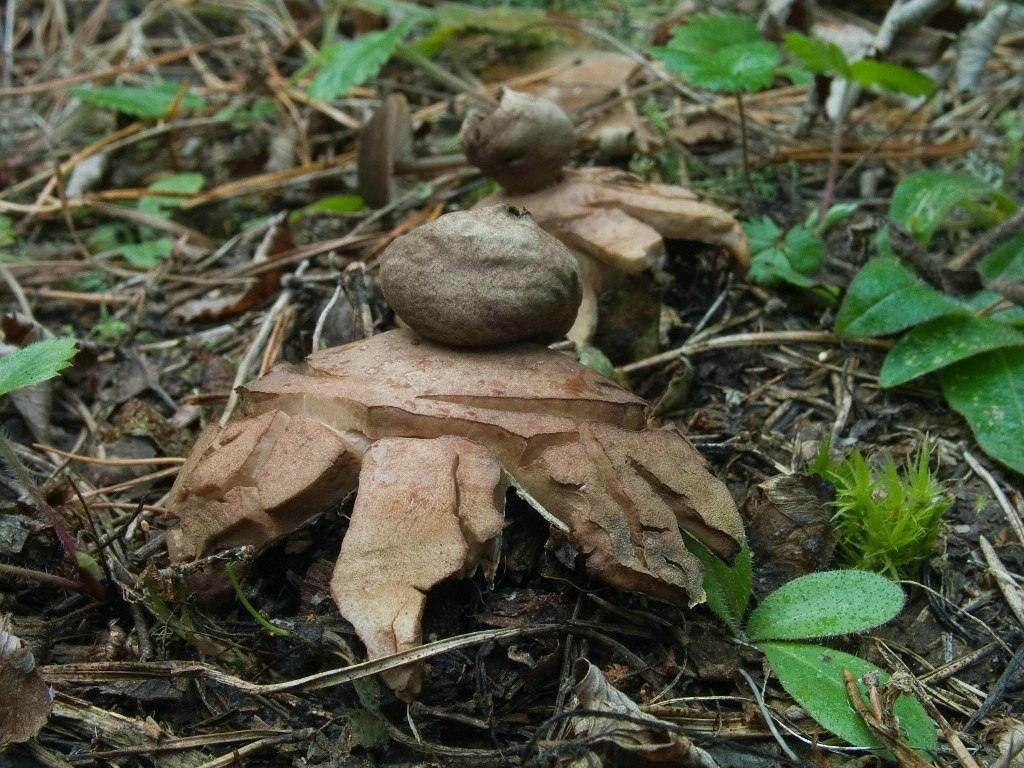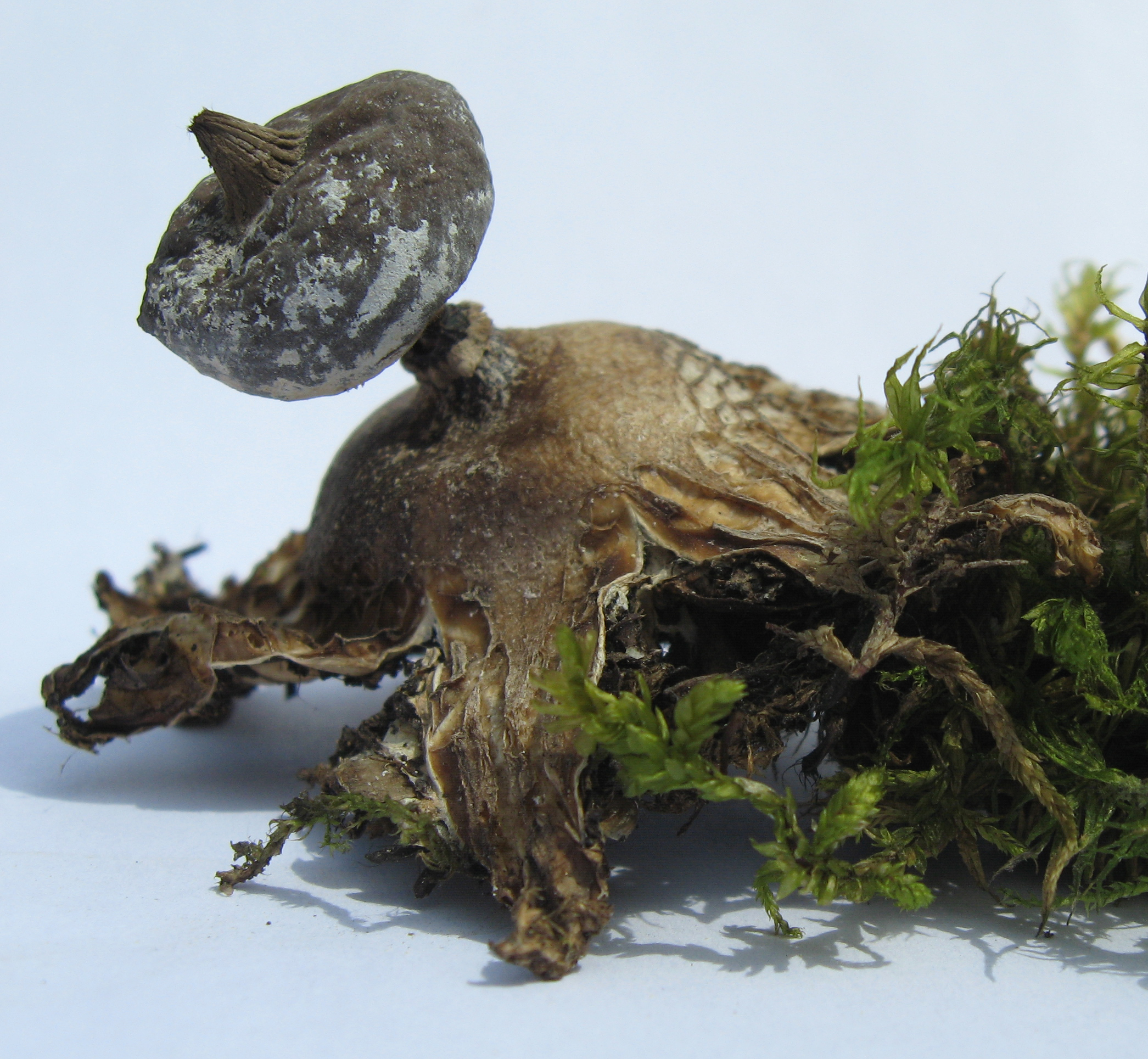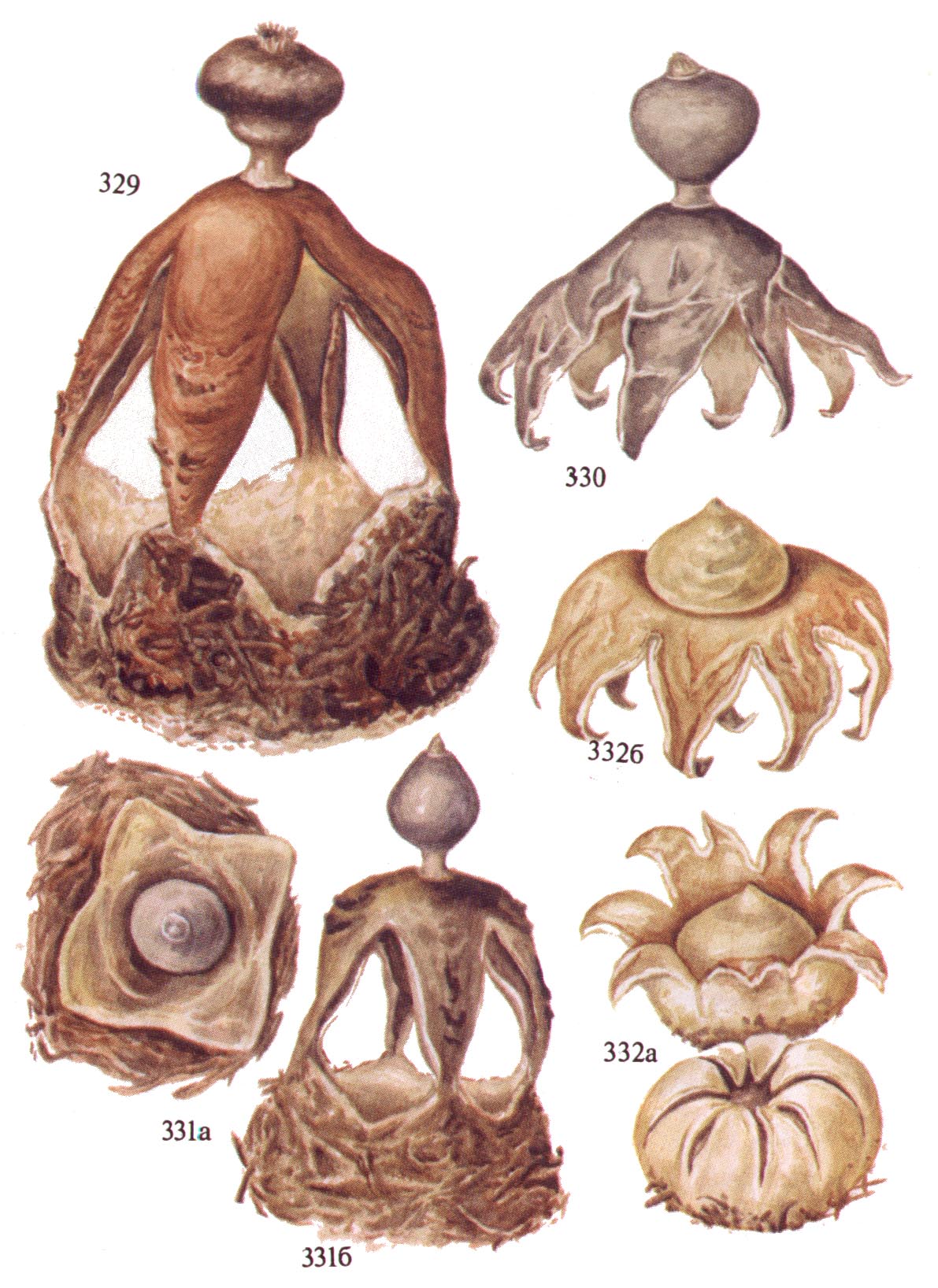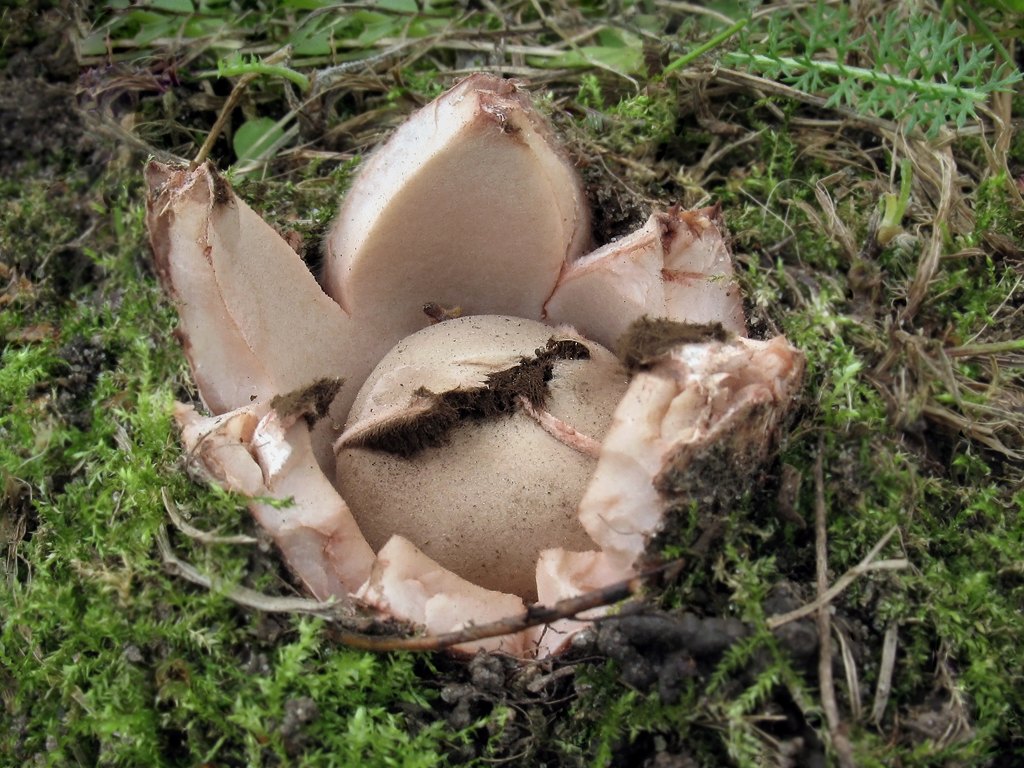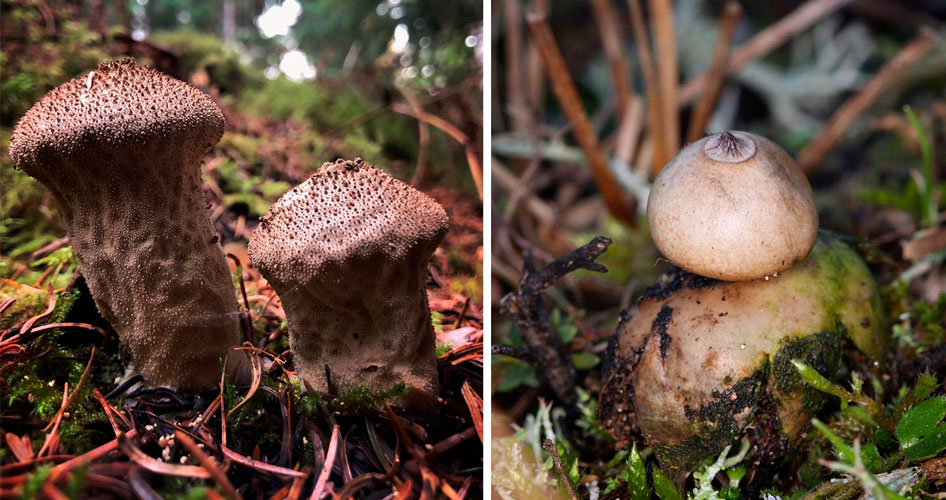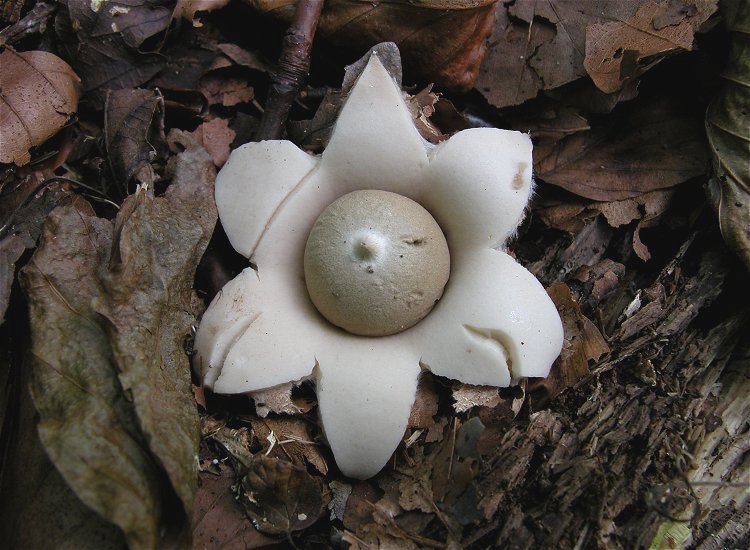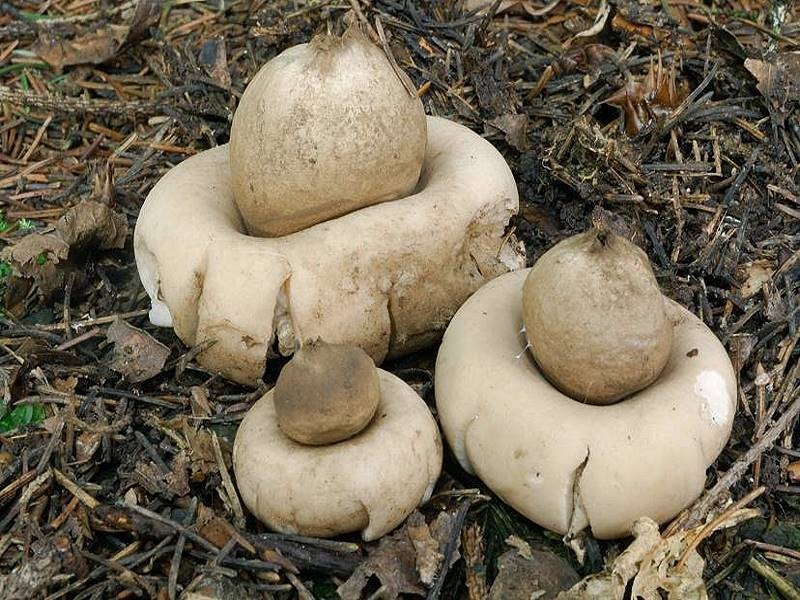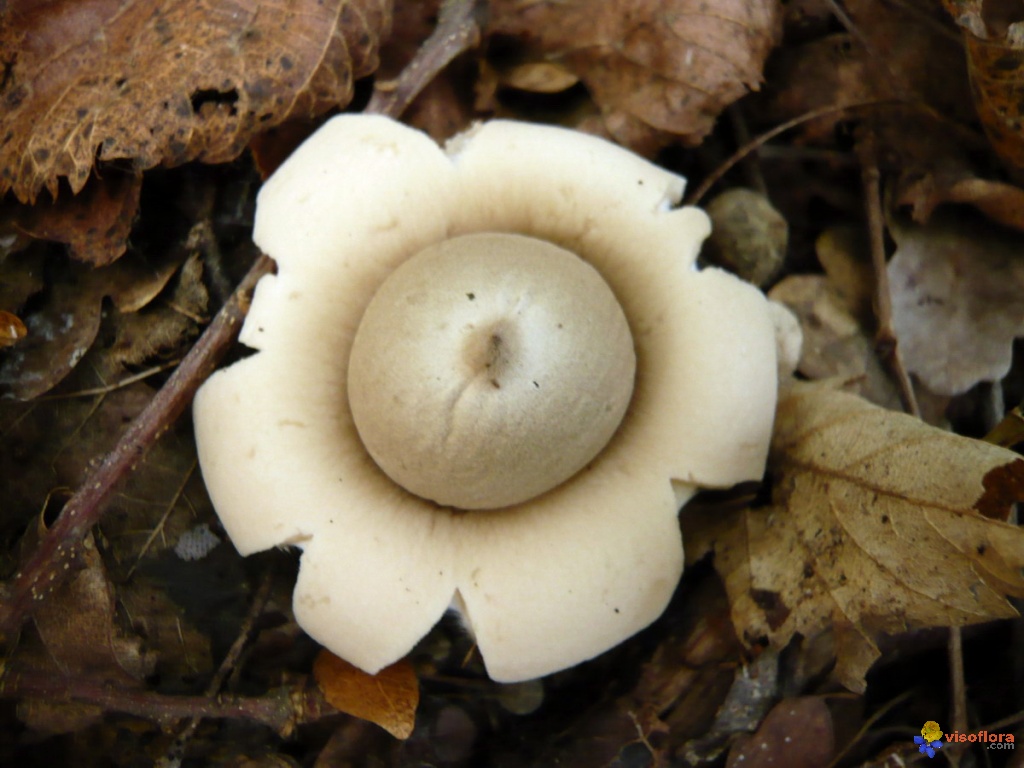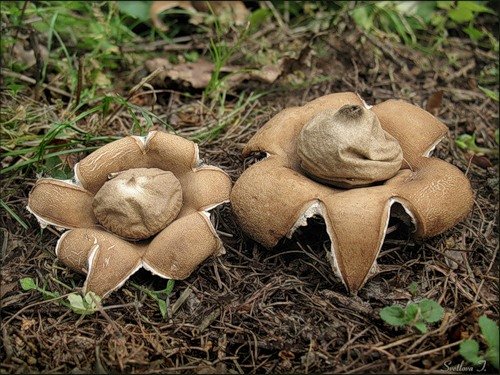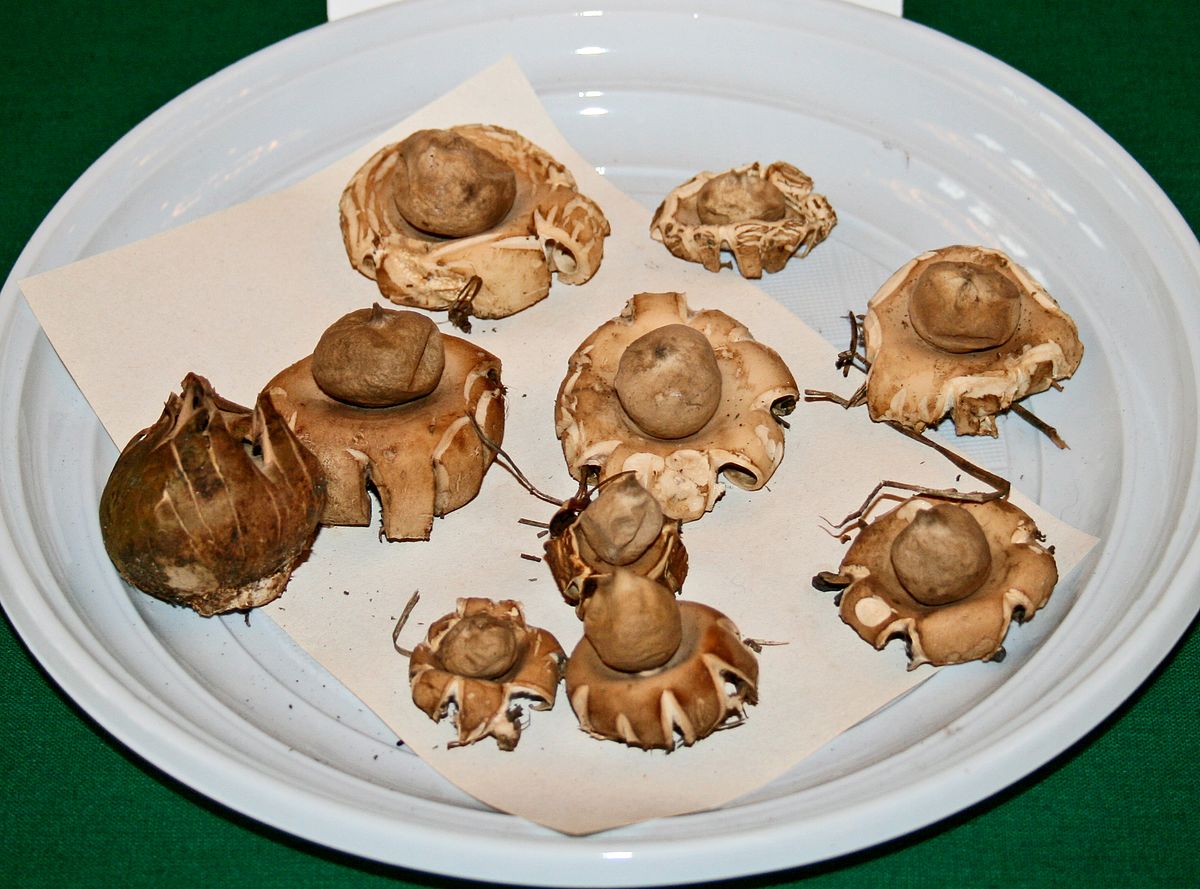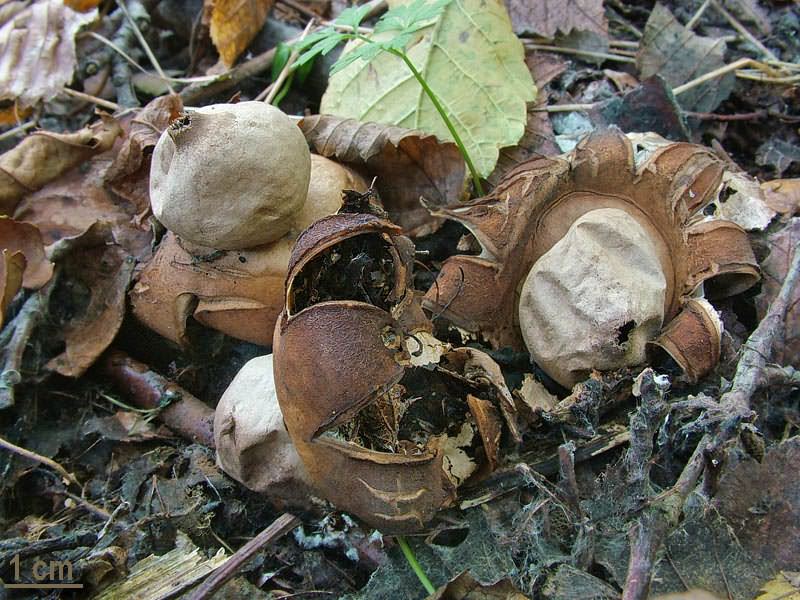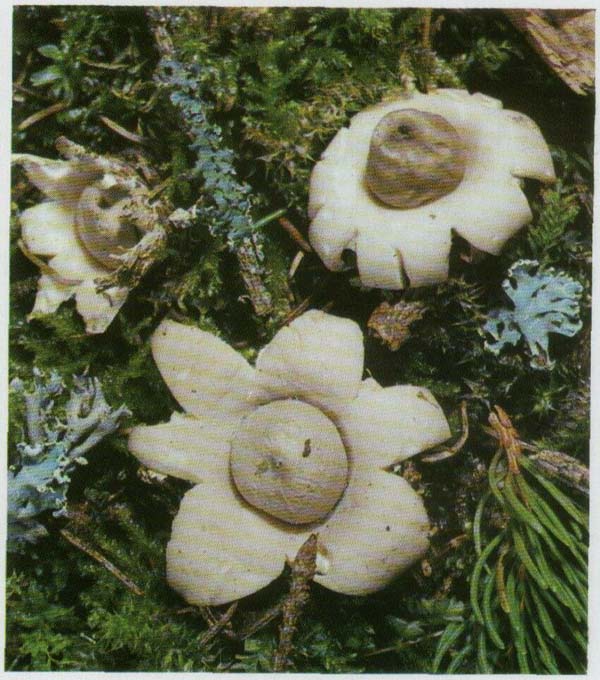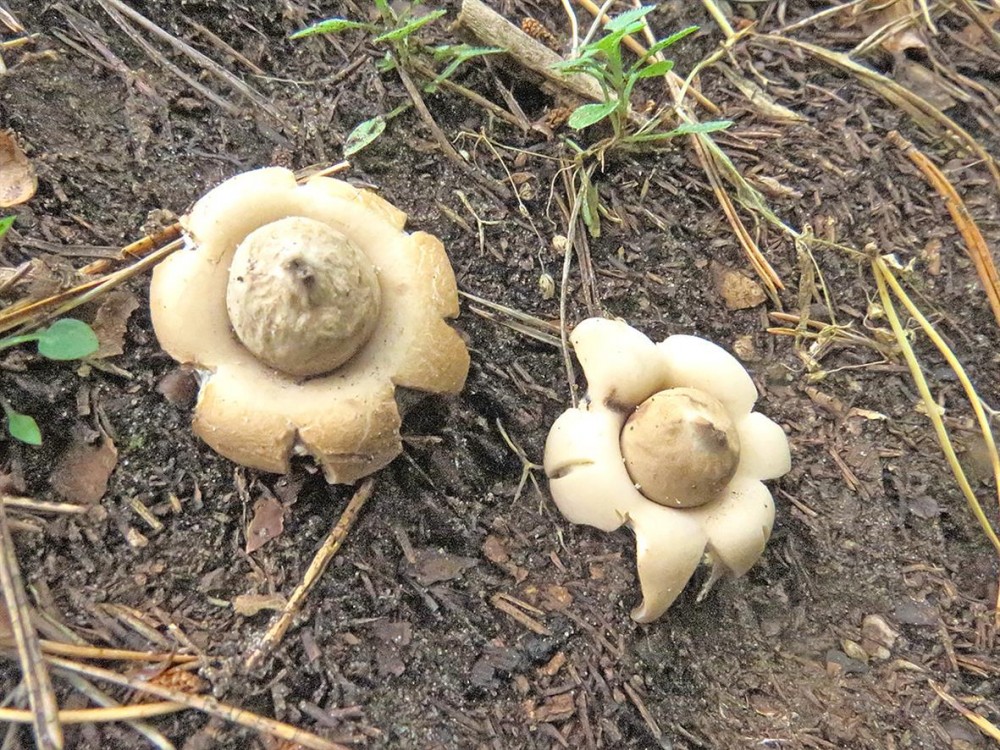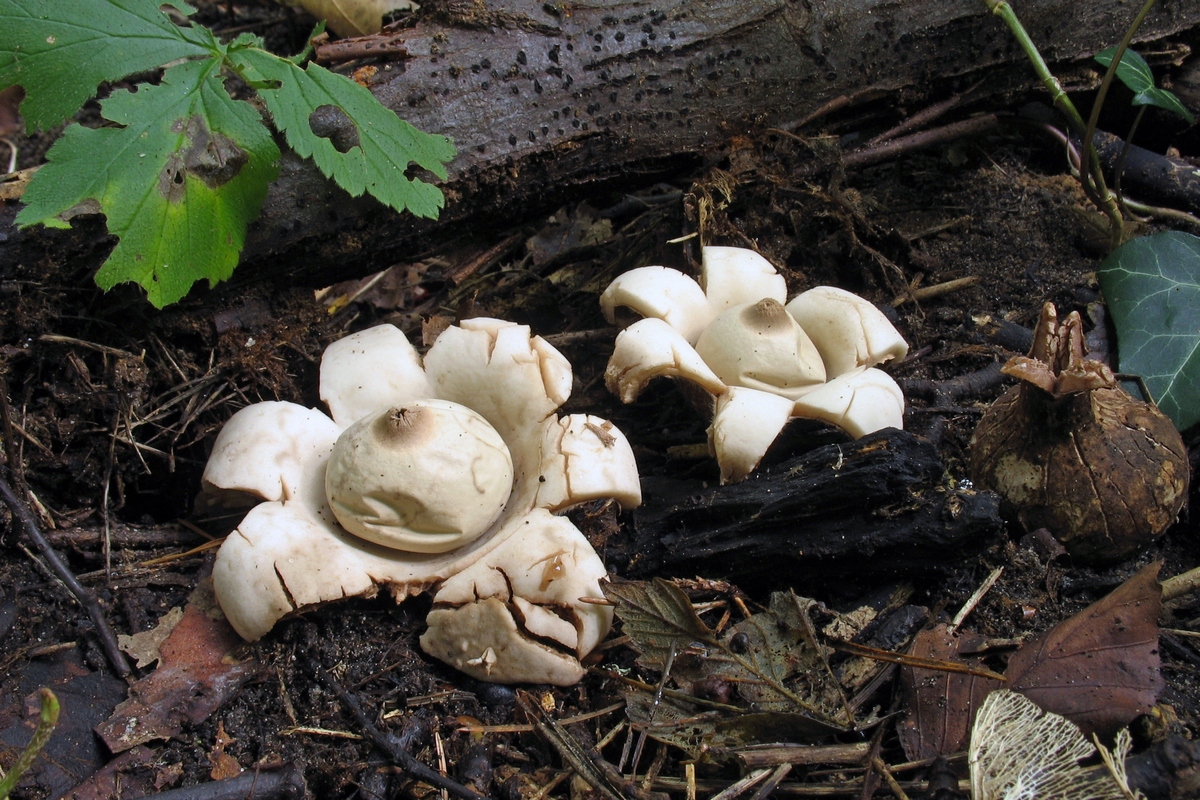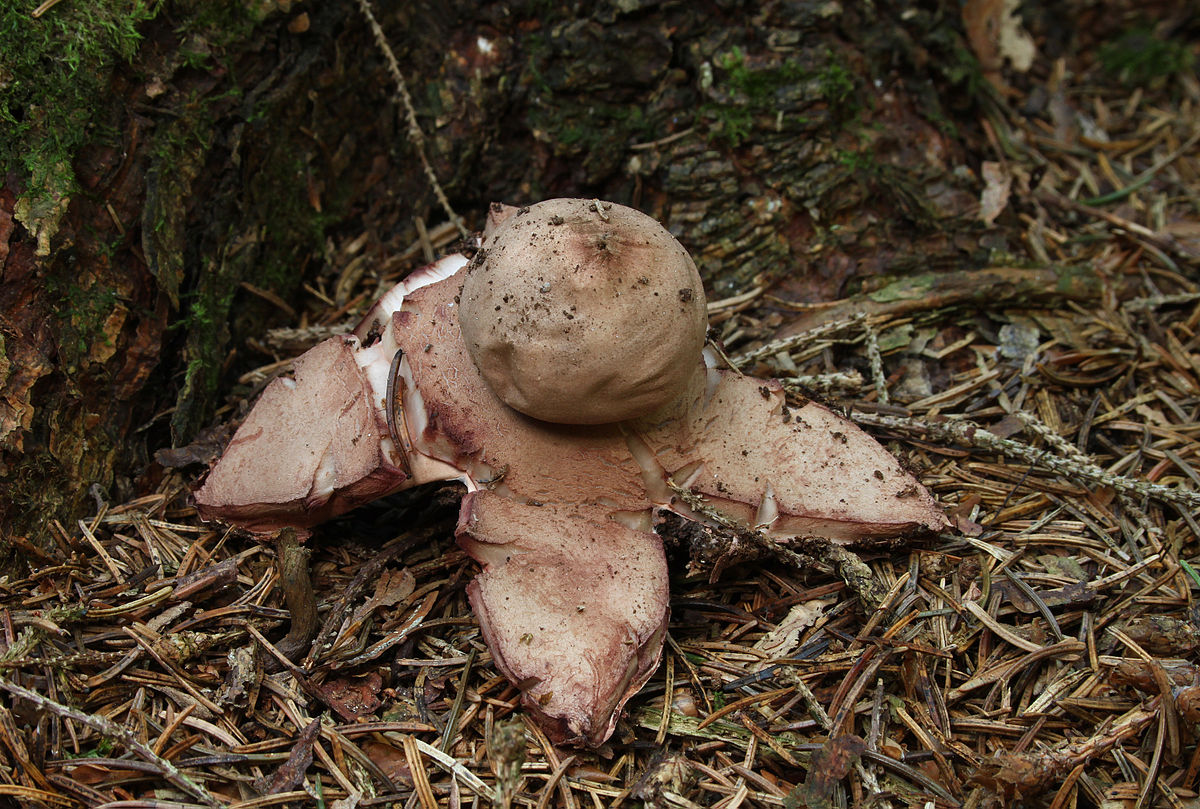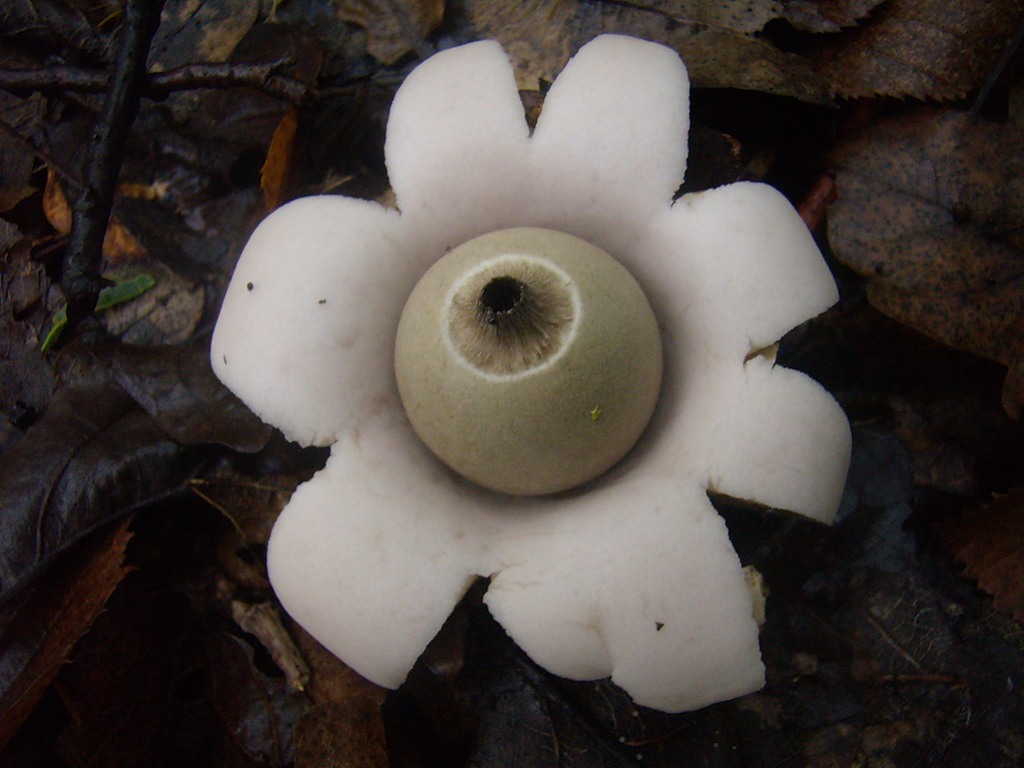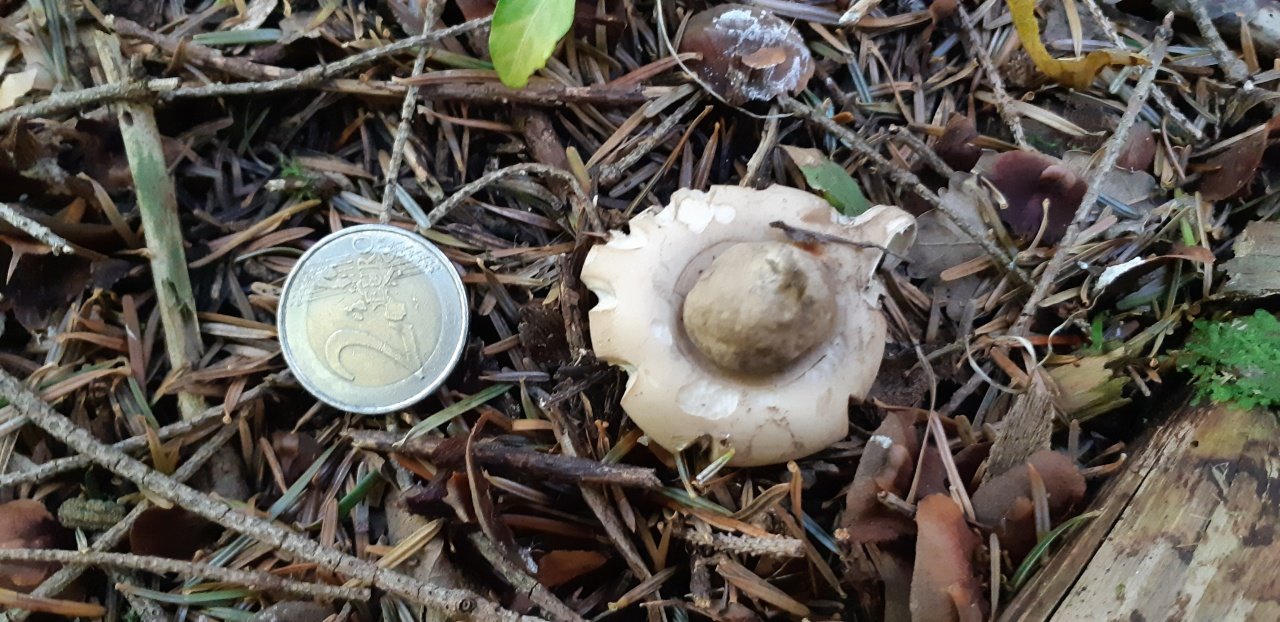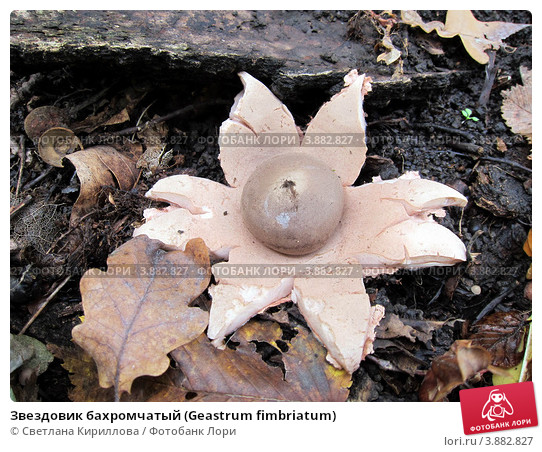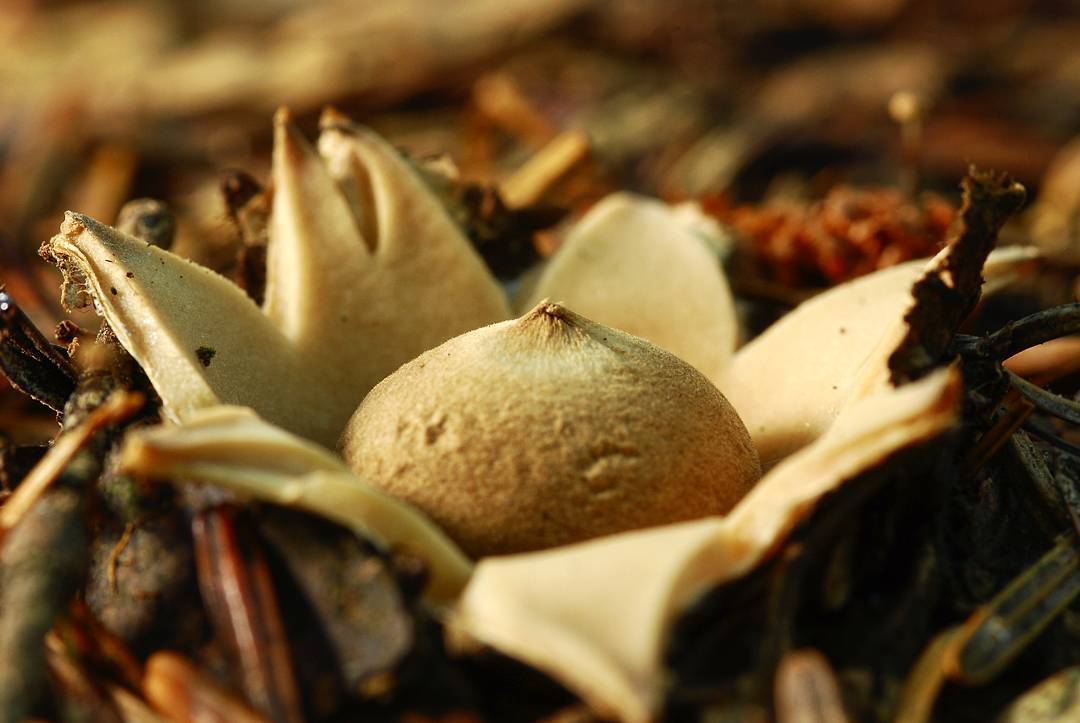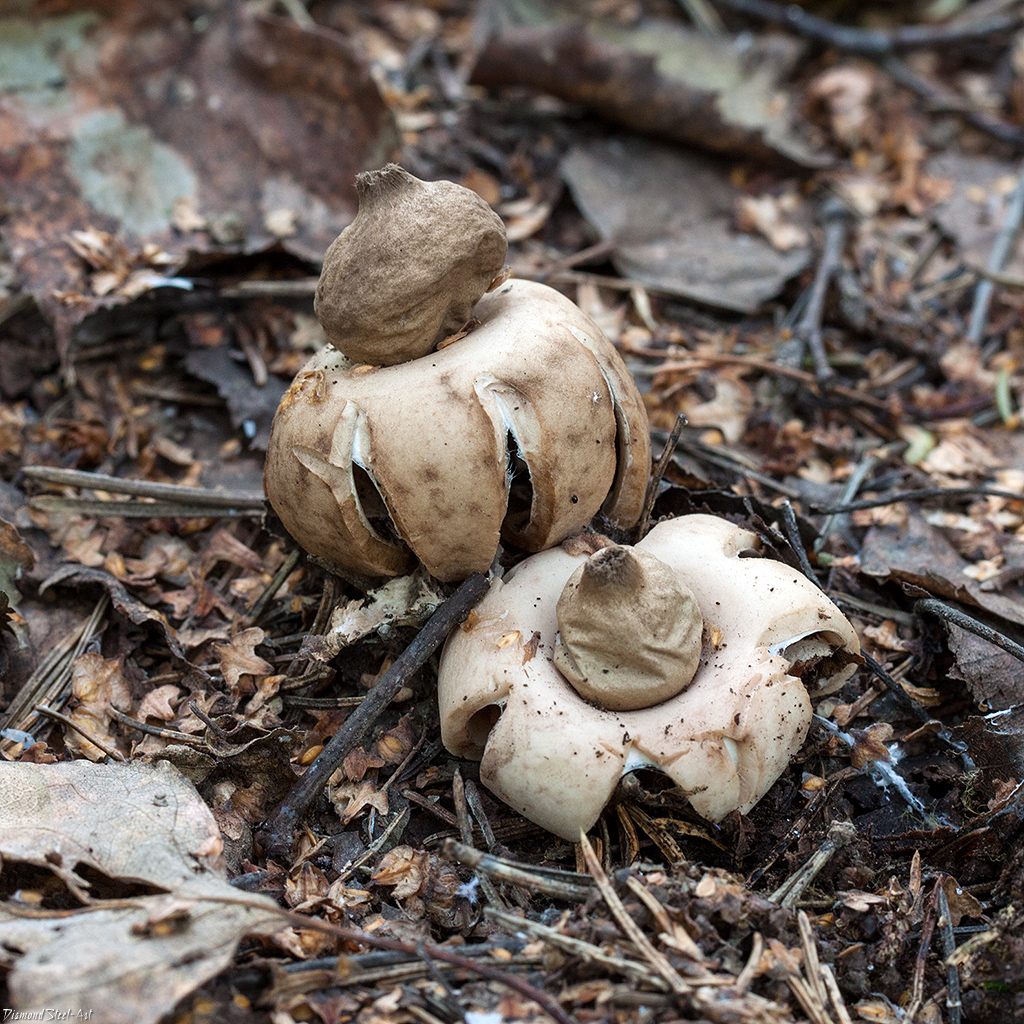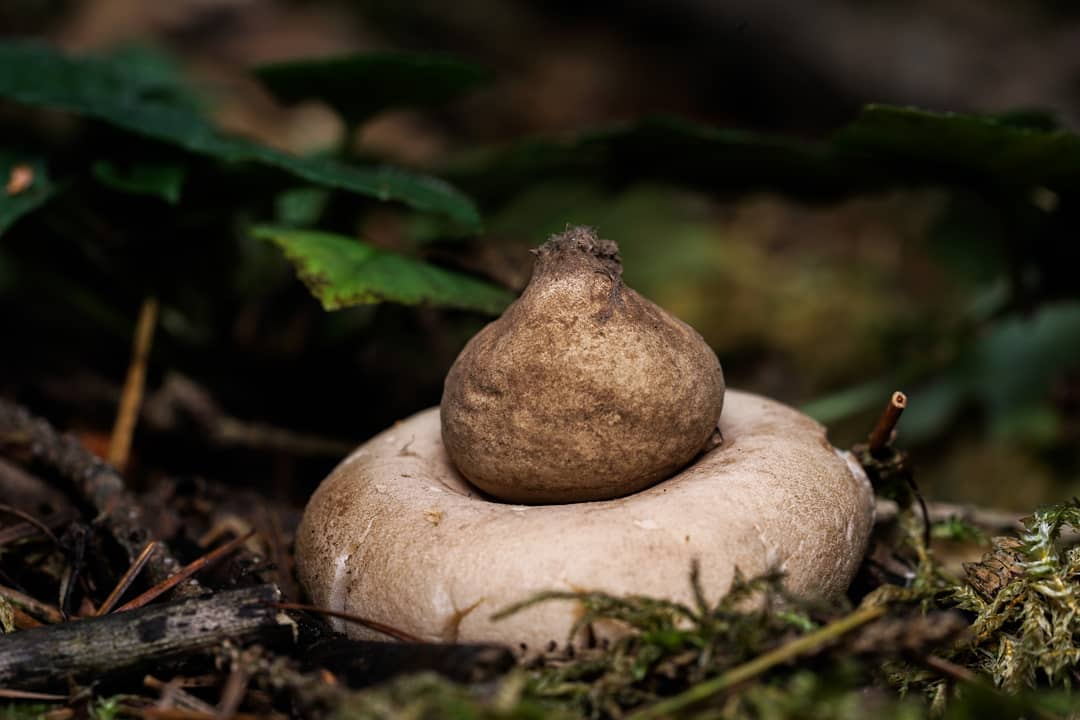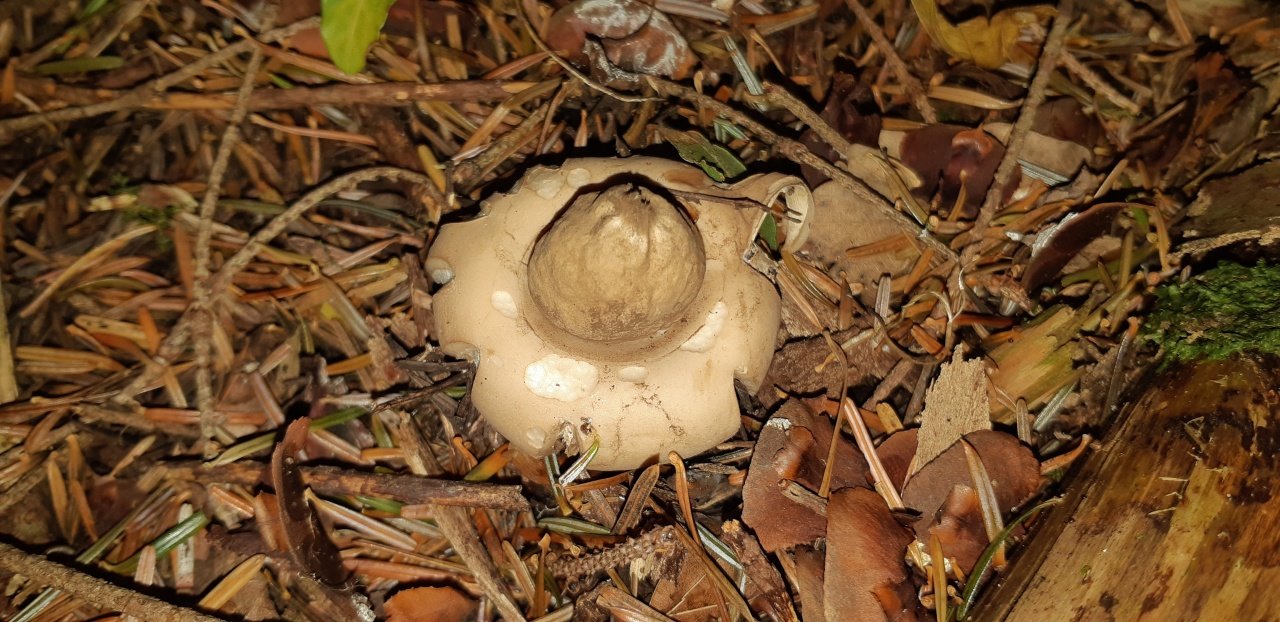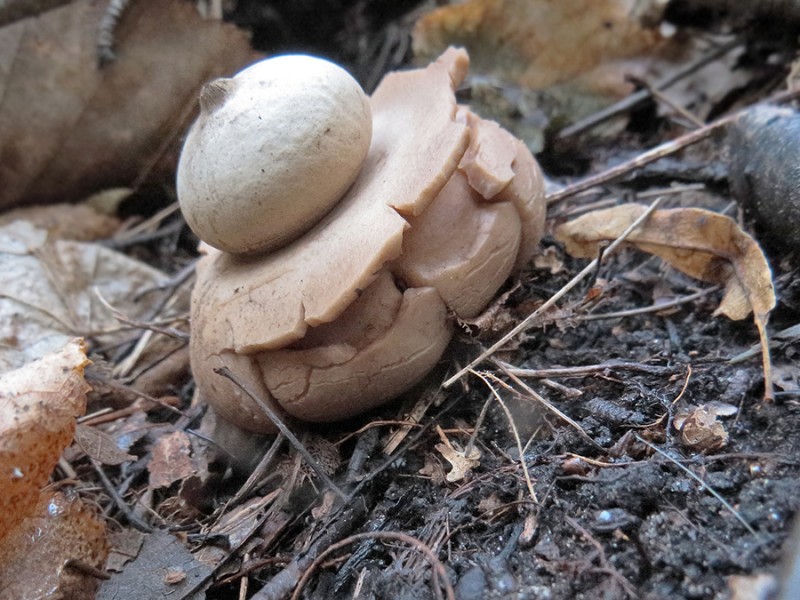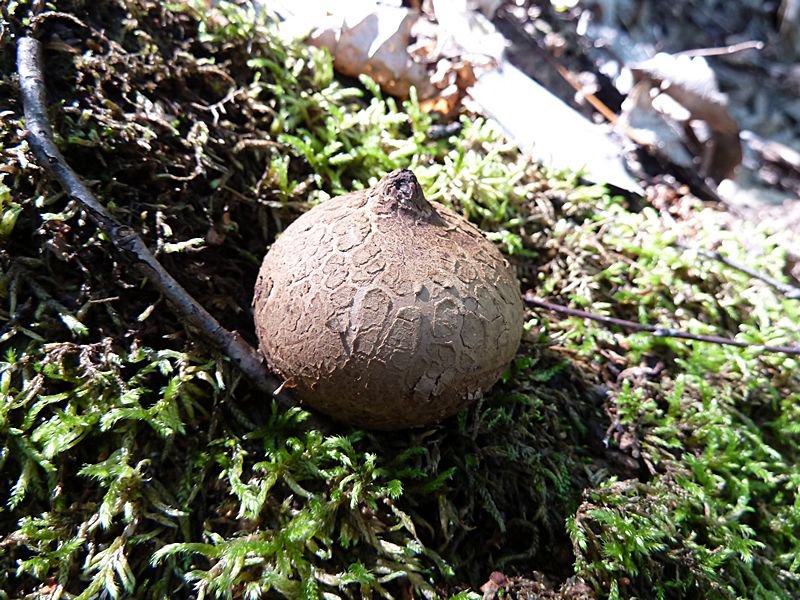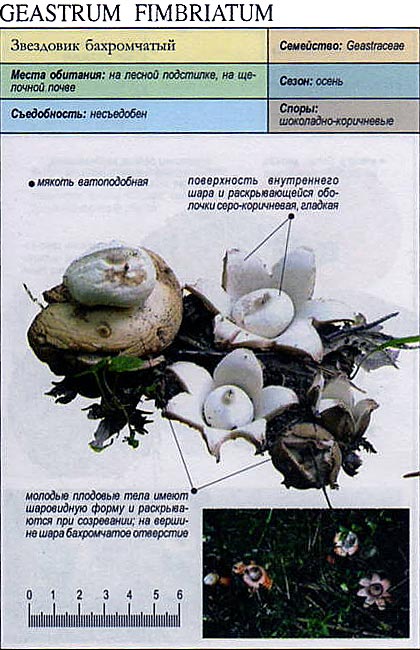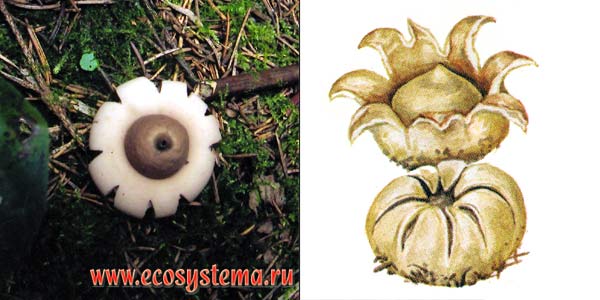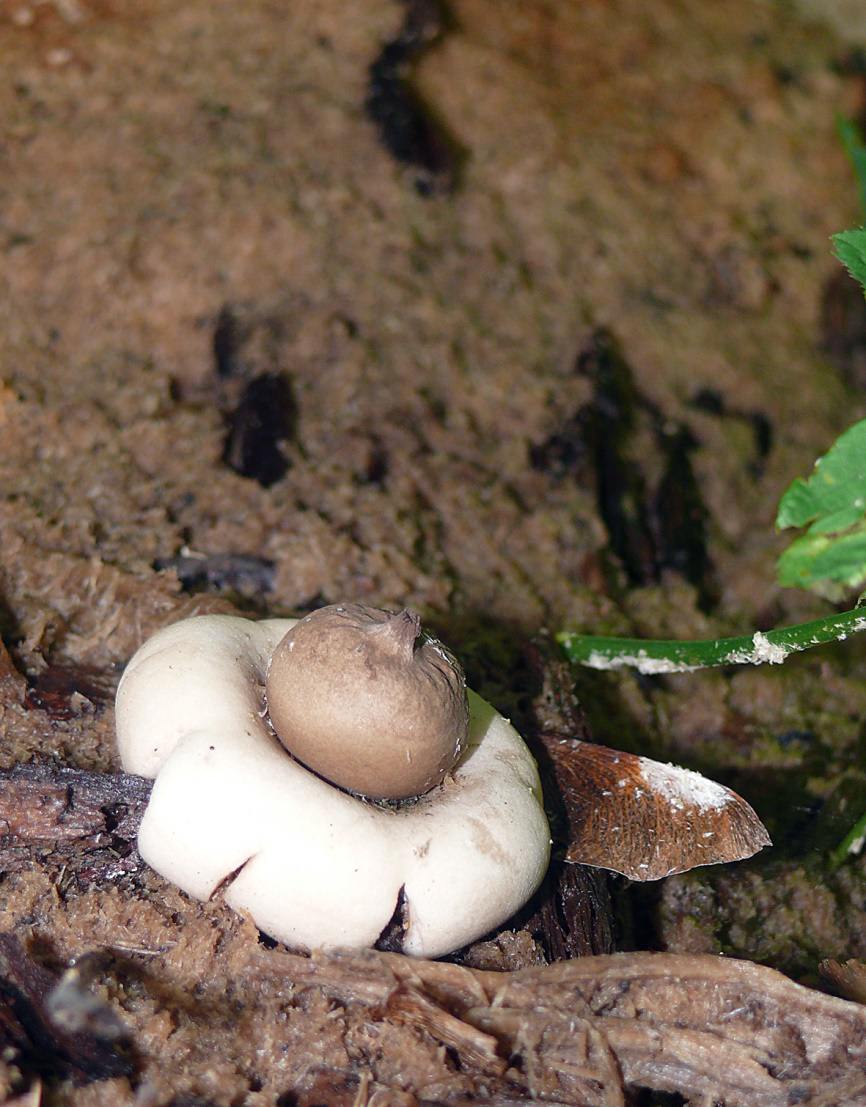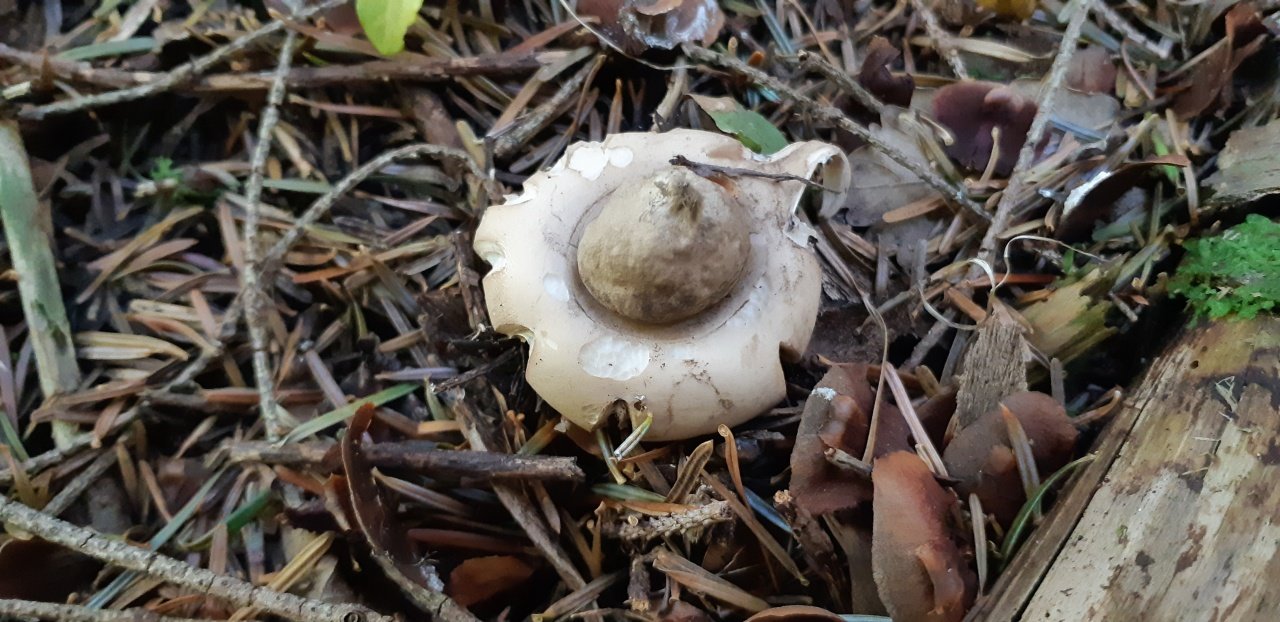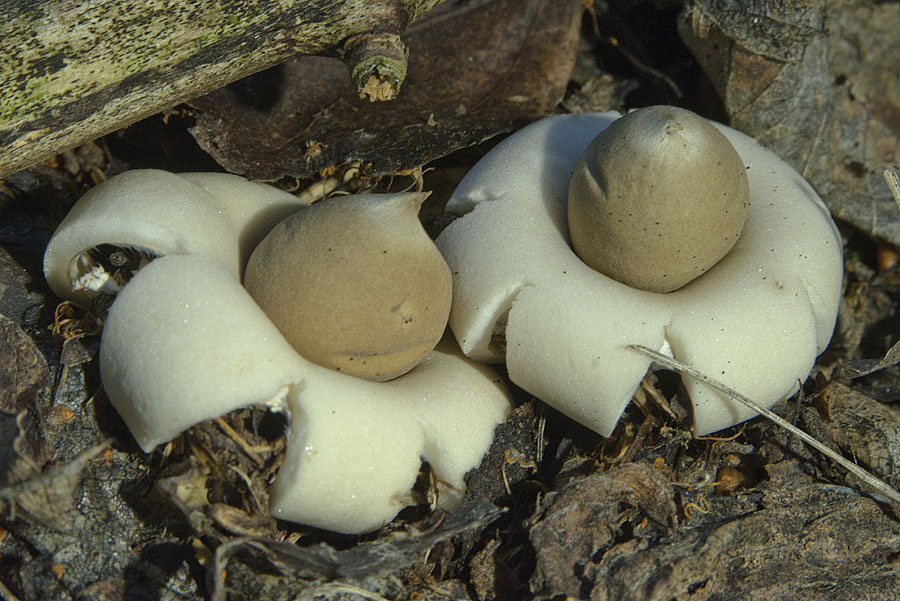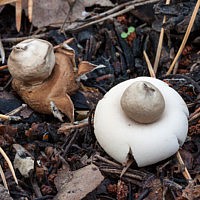Geastrum quadrifidum
- Other names for the mushroom:
- Starfire four-bladed
- Geastrum four-bladed
Synonyms:
- Star wheel four-part
- Geastrum four-bladed
- Earth star four-bladed
Description
Fruiting bodies are initially closed, spherical, about 2 cm in diameter, covered with a peridium, along the entire surface of which mycelial strands are located; mature - open, 3-5 cm in diameter. Peridium is four-layer, consists of exoperidium and endoperidium. Exoperidium in the form of a bowl, three-layer or two-layer, hard, breaks from top to bottom to the middle into 4 unequal, pointed parts (lobes), bending down, and fruiting bodies rise up on the lobes, as on "legs". The outer mycelial layer is whitish, felt, covered with soil particles, soon disappears. The middle fibrous layer is white or isabella, smooth. The inner fleshy layer is white, also torn into 4 parts, with sharp ends resting on the sharp ends of the blades of the outer layer, soon disappears. The base is convex. The middle rises up together with the inner part of the fruiting body - the gleba. The spherical or oval (ovoid) glebe is covered with endoperidium, 0.9-1.3 cm high and 0.7-1.2 cm wide. At the base with a flattened leg, above which the endoperidium is narrowed and a well-visible rounded protrusion (apophysis) is formed, at the apex it opens with an opening, which is equipped with a low peristome. The peristome is conical, fibrous, with a sharply limited courtyard, smoothly fibrous-ciliate, around which there is a clear ring. The stem is cylindrical or slightly flattened, 1.5-2 mm high and 3 mm thick, whitish. The column is cotton-wool, light brown-gray in section, 4-6 mm long. Its exoperidium ruptures more often by 4, less often by 4-8 unequal pointed lobes, bending downward, which is why the entire fruiting body rises up on the lobes, as on legs.
The leg (in the traditional sense) is missing.
Gleba is powdery when ripe, black-purple to brown. Spores are brownish, light or dark brown.
When pressed, the spores fly in all directions. Spores are olive brown.
HABITAT AND GROWTH TIME
The four-part starfish grows mostly on sandy soil in deciduous, mixed and coniferous - pine, spruce, pine-spruce and spruce-deciduous forests (among fallen needles), sometimes in abandoned anthills - from August to October, rarely. Recorded in Russia (European part, Caucasus and Eastern Siberia), Europe and North America. We found it southeast of St. Petersburg in a mixed forest (birch and spruce) under an old spruce on needles in early October (the mushrooms grew as a family).
TWINS
The four-part starfish is very peculiar in appearance and is strikingly different from mushrooms of other genera and families. It is similar to other starfish, for example, to the Vaulted starfish (Geastrum fornicatum), whose exoperidium splits into two layers: the outer one with 4-5 short, obtuse lobes and the inner, convex in the center, also with 4-5 lobes; on Zvezdovik crowned (Geastrum coronatum) with leathery, smooth exoperidium, splitting into 7-10 gray-brown pointed lobes; on Fringed Starfish (Geastrum fimbriatum) with exoperidium, which is torn by half or 2/3 - by 5-10 (less often up to 15) unequal blades; on Zvezdovik striped (G. striatum) with exoperidium, bursting into 6-9 lobes, and light gray gleb; on the small Starfish Shmiela (G. schmidelii) with exoperidium, forming 5-8 lobes, and a gleba with a beak-shaped grooved striped nose; on Zvezdovik triple (Geastrum triplex) with a fibrous hole at the top of a gray-brown block.
It is confined to the soils of deciduous and coniferous forests.
Mushroom application
The benefits of earthen stars are closely related to their use. They do not have any toxic substances, they are similar to raincoats. They are rarely used for food: they do not have a pronounced taste or smell. Previously, such mushrooms are not boiled.
In folk medicine, the star and its controversy are more popular. They found practical applications:
- the body of a young starfish, cut into plates, replaces the plaster and dressings, because it successfully stops blood and is able to help the speedy regeneration of the wound;
- a powder is made from mature spores, it is also added to medicinal tinctures;
- geastrum, or starfish, are rich in chemical components, therefore extracts from them are used as antiseptics and antineoplastic agents.
Inedible species
The star family are mostly inedible species of mushrooms, at the same time they are not poisonous. Often, representatives of this family are used in traditional medicine.
- The triple earthen star is a mushroom slightly different from related species, which is characterized by a double layer of the outer shell. When ripe, the surface bursts into pieces, forming an unequal number of rays, and the inner one turns into a kind of border framing the spore-bearing body, thus forming a bowl. The color of the mushroom body is from light beige to brownish.
- Striped starfish - as well as the form described above, has characteristic differences. The mycelium of this type of mushroom is located not like most representatives of this family - under the surface of the earth, but above it. As the specimens mature, the fruiting body forms long, creamy rays that give the mushroom the shape of a star. Over time, these rays crack and darken significantly. An elongated spore-bearing body of small size is located on a small and rather powerful stalk. Differs in a characteristic gray color with a light bloom. The central part is divided by stripes.
- Fringed starlet is a mushroom whose fruit body is partially hidden under the ground. The outer shell of a brownish tint, as a rule, bursts into 6-7 parts bent to the bottom. The sphere with spores is gray; there is a weakly outlined bowl (courtyard) bordering it.
- Crowned starfish is a mushroom with gray rays having a matte shade. The spore-bearing part is located on a thin and rather short stalk. The immediate central part is darker than star-like.
- Small star - the smallest geastrum in size. The parts of the outer shell, as a rule, are divided into a fairly large number of parts (up to 12). The color of the rays is light beige, they crack over time, exposing the lighter inner part. The spore body is gray, darkens with maturation, at the apex there is an elongated proboscis.
- The black-headed geastrum is a subspecies of the family that has significant differences. At the beginning of growth, the body of the fungus resembles such a species as a raincoat, which has a characteristic light color of the fruiting body; as it grows, the shell divides into parts (up to 8), opening the body of the spore-bearing ball. Note that the inner part of the rays is covered with dark mature spores, which are carried by the wind in bad weather.
- Four-pointed earthen star - this species, like many of its congeners, during the ripening period raises the fruit body above the surface of the soil. The color of the fruit body is gray-white, spore-bearing - gray.
Unusual mushrooms from the families Star and Pseudo-raincoats
Fringed starfish (Geastrum fimbriatum).
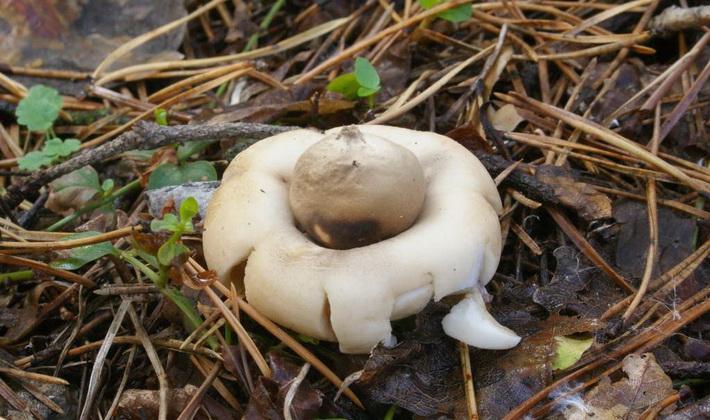
Family: Starfish (Geastraceae).
Season: Autumn.
Growth: in groups or rings.
Description:
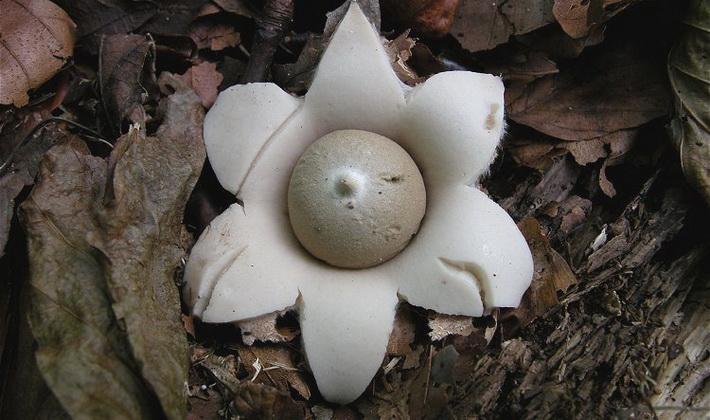
The fruit body is initially spherical and develops in the ground. Later, the three-layer, rigid shell breaks open and spreads outward like a star.
The hole for the exit of spores is fringed.
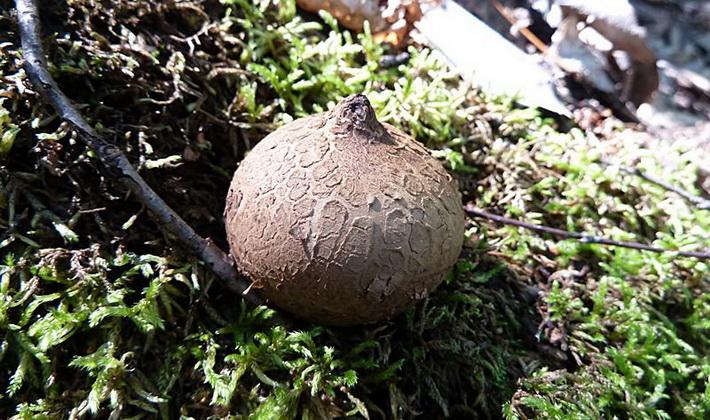
The spore sac is light gray, with a thin shell.

Individual blades begin to curl as the fruiting body emerges from the ground.
Ecology and distribution:
Grows on a litter in alkaline soil under coniferous and deciduous trees.
Schmidel's starfish (Geastrum schmidelii).
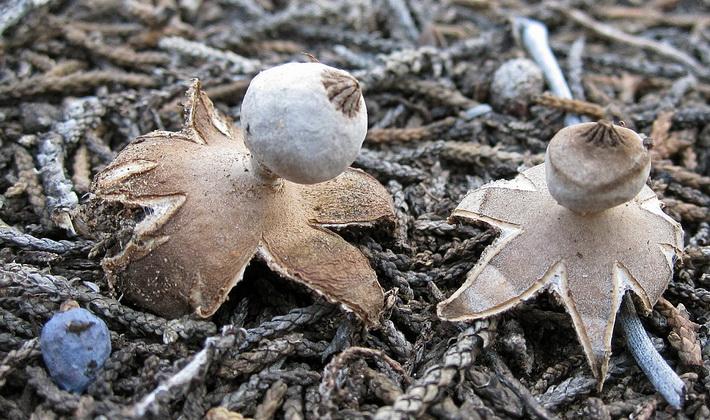
Family: Starfish (Geastraceae).
Season: July - September.
Growth: in groups and singly.
Description of the unusual mushroom star Schmidel:
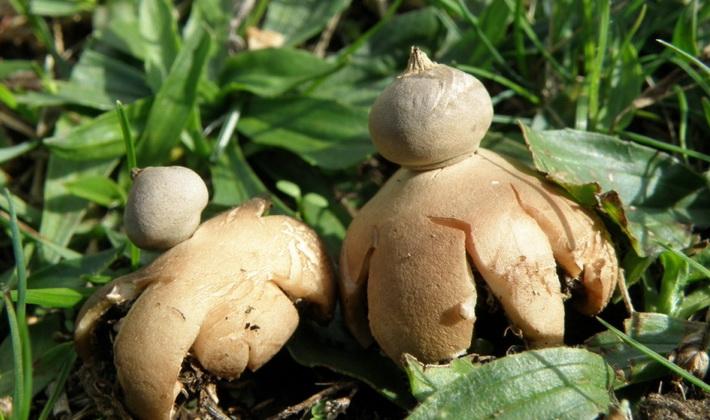
The spore sac is leathery, brown, with a small pedicle; the opening for the exit of spores is surrounded by a fibrous fringe.
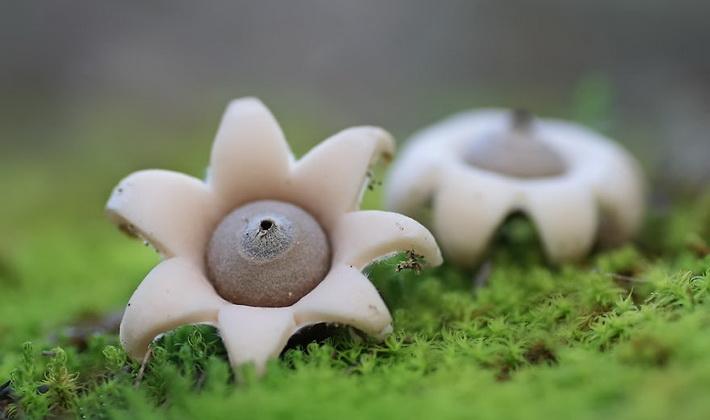
The inner side of the shell is smooth, rarely cracking, from light brownish yellow to light brown.
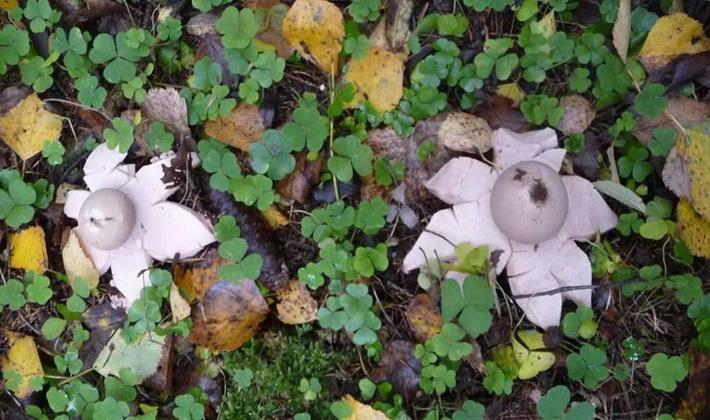
The thin outer shell of the fruiting body is torn into 5-8 unequal sharp lobes, turning downward.
Inedible mushroom.
Ecology and distribution:
Grows on soil and litter in deciduous and coniferous forests and forest plantations, in the steppes on the soil. Prefers light sandy loam soils. In Russia, it is found in the southern regions of the European part, Siberia and the Far East.
The earth star is triple (Geastrum triplex).
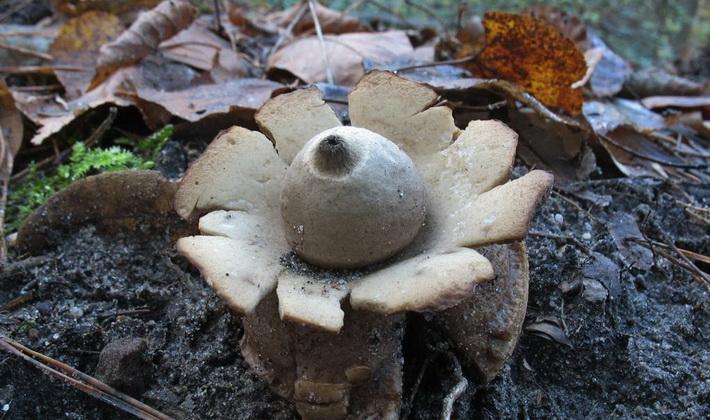
Family: Starfish (Geastraceae).
Season: late summer - autumn.
Growth: in groups.
Description:
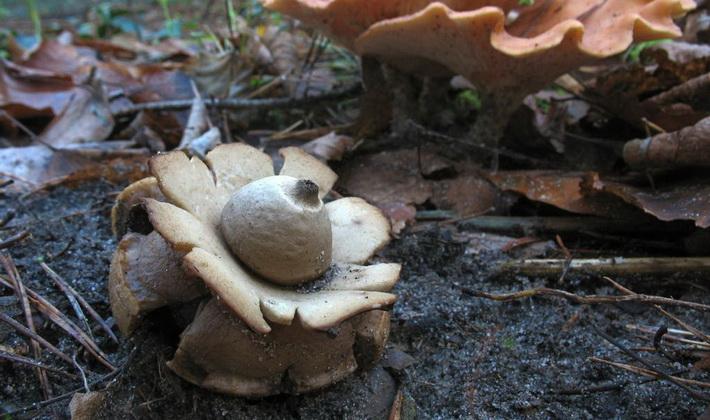
The outer layer of the shell, when ripe, forms a "star". The young fruit body has a turnip shape.

The hole for the exit of spores is surrounded by a depressed platform. The inner layer of the shell forms a characteristic “collar”.
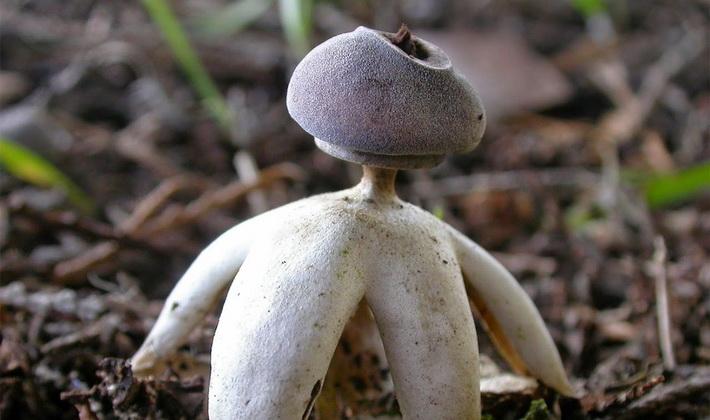
The spore sac is brownish.
Inedible mushroom.
Ecology and distribution:
Grows in deciduous and mixed forests, among fallen leaves and needles.
Hygrometric starfish (Astraeus hygrometricus).
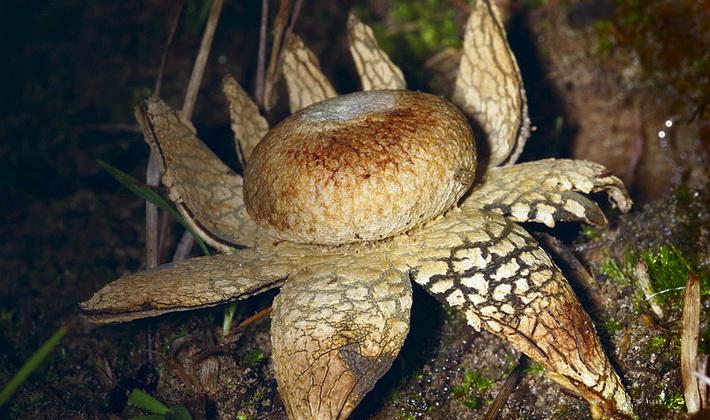
Family: Sclerodermatineae.
Season: all year round.
Growth: in groups.
Description:
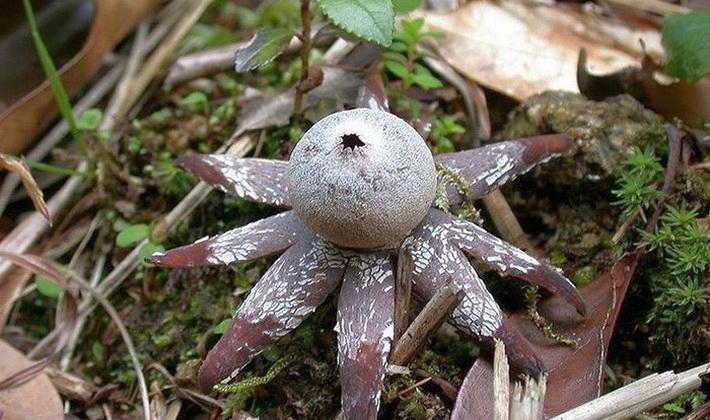
When ripe, the outer shell cracks from top to bottom into 5-20 pointed blades. In dry weather, the blades bend, hiding the spore sac, and when the humidity rises, they straighten.
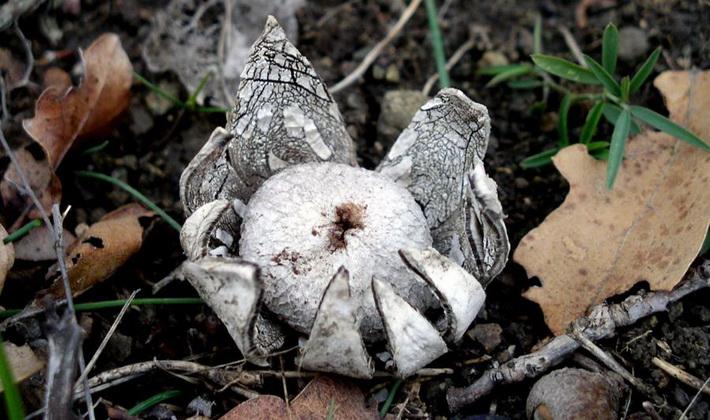
The inner surface of the blades is from gray to reddish-brown, rough, covered with a network of cracks and lighter scales. The spore sac is covered with a gray, gradually darkening shell.
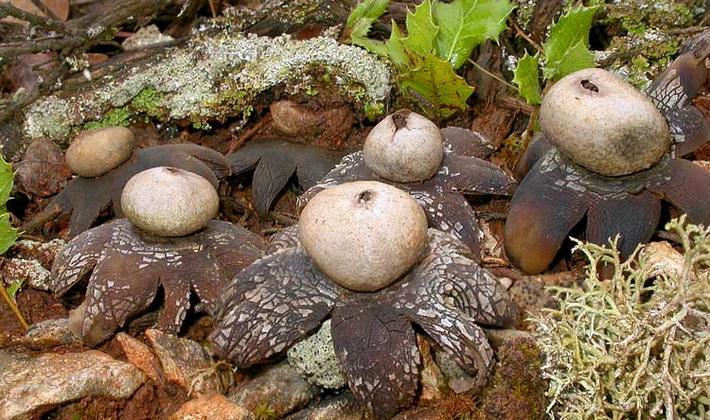
The unripe fruit body is rounded, with a multilayer shell, reddish brown.
Inedible mushroom.
Ecology and distribution:
It grows on dry, stony and sandy soil and on loams in sparse forests, steppes and semi-deserts. In Russia, it is found in the European part, in the North Caucasus, in Siberia, in the Far East.
Here you can see photos of unusual mushrooms, the names and descriptions of which are given above:
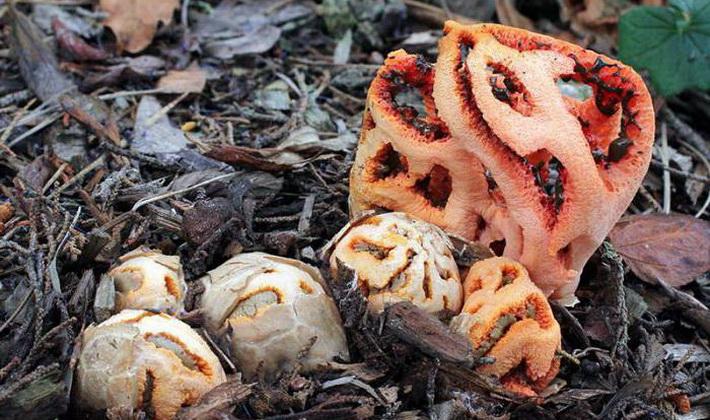

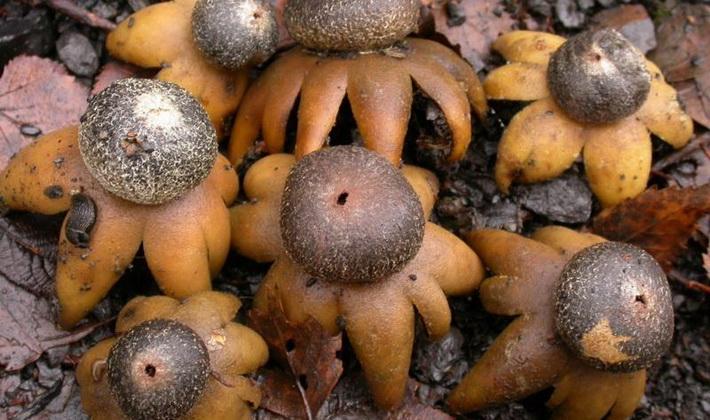
Mushroom species
Starfish species are divided into 2 main groups. Some mushrooms are eaten at a young age, while others are not suitable for cooking. Old eukaryotes of any kind do not eat: they lose their attractiveness, become hard and tasteless, but they have other beneficial properties.
Inedible starfish species
Geastrooms are mostly non-edible, although they have interesting external features. They do not belong to poisonous mushrooms either. Inedible starfish are used in folk medicine. They have several types with their own characteristics:
- The star is triple: in its appearance, it has features that somewhat distinguish it from its fellows. It has a double layer of the outer shell (peridium), the upper part of which bursts into several unequal parts, and the inner one forms a bowl around the spore-bearing body. On the upper part of the spherical bag with spores, a kind of belt is formed, called a courtyard. The color of the mushroom body can become beige or light brown.
- Starfish striped: the young fruiting body is located underground and resembles a bulb in shape. As it matures, the body of the fungus spreads out long, creamy, star-shaped blades that crack and darken over time. The spore body has a small diameter, elongated shape, sits on a small thick stalk. It has a gray color, covered with a whitish bloom, the tip at the top is characterized by pronounced stripes, which is where the name of the species comes from. The main difference of the species is the location of the mycelium - on the soil surface, and as it is "accepted" - in the soil.
- Starfish crowned: has gray dull lobes on the outer shell of the mushroom body. The spore-bearing part rises on an elongated neck. But the leg is missing. The color of the ball is much darker than the star-like part of the geastrum, more like a brown tint.
- Fringed starfish: partially reveals its fruiting body from the ground. The outer shell (of the side) has a yellowish-brown tint, breaks into 5-7 lobes, which are strongly curved downward. The spore-bearing ball is gray in color and has a poorly defined courtyard. When looking from above at the organism of the fungus, one can clearly see at the edges of the blades a kind of denser fringe formed from the upper layer of the peridium.
- Small starfish: this species is called the smallest representative of the Geastrov family. The lobes of the upper layer of the mushroom body crack into 8-12 equal parts in the horizontal plane, then the mushroom body rises slightly. The color scheme of the star's petals is closer to beige-gray; over time, cracks appear with a lighter inner content. A spore-bearing gray ball becomes brown closer to ripening, the proboscis elongates at the apex. Interestingly, the endoperidium (inner layer of the shell) is characterized by the presence of a kind of crystalline coating.
- Black-headed starfish: is a special species. Its appearance in youth and maturity can be said to be strikingly different. When the mushroom body is still young, it resembles an ordinary light or slightly brownish raincoat. As it matures, the outer shell bursts into 5-8 parts, exposing the spore-bearing ball. The inner part of the star's rays and the top itself are covered with a rather thick layer of dark, often black, mature spores, which are immediately carried away by wind and rain.
- Four-lobed starfish: during the ripening and blooming of the "petals" it also raises the body above the ground. The color of the outer layer is gray-white, and the spore-bearing ball is dark gray. A special feature of the eukaryote is a pronounced flattened rim around the hole at the top of the ball - a courtyard.
Conditionally edible mushrooms
Only young mushrooms are suitable for consumption.
Young mushrooms from the Geastrov family are eaten as an exotic supplement. These species are few in number. In a state of physiological maturity, mushrooms are no longer suitable for human consumption.
Vaulted starfish: This is one of the rarest species, characterized by a flattened or spherical underground body. When the upper layer is separated, ingrown fragments of litter remain on the visible side of the blades, which create the appearance of cascades and canopies. The color of the outer part is brown, the spore-bearing ball is flattened, fawn, matte.
Description
Fruit bodies Starfish Fringed begin roughly spherical and hypogeous. As it matures, it is pushed upward through the soil, and another layer of case spores (exo-peridium) splits to form between 5 and 8 beams that curve downward. The fully expanded fruiting body measures up to 3 cm (1.2 in) in diameter. Before expansion, the outer surface has a surface with cottony adherent soil particles; it eventually flakes off to reveal a smooth, greyish brown surface. The inner spore sac is yellowish brown and has small conical pores with fringed edges. Unlike other similar earthstar fungi, the edges of this pore are not sharply demarcated from the rest of the sac spores, and are not grooved. Fruit bodies do not have a characteristic taste and smell.
These spores are spherical, rough with many small dots or warts, and measure 2.4-4 µm. The capillium is thick-walled, unbranched and 4-7 microns thick.
Similar species include Saccatum starfire which are larger - up to 5 cm (2.0 in) across - and have a well-defined annular zone around the pore opening. Zvezdovik reddish has reddish tones that are absent in G. fimbriatum .
Although generally listed by field guides as an inedible species, it is eaten by the tribal peoples of Madhya Pradesh.
Description of the mushroom
The fruit develops below the surface of the earth and has a spherical shape. The shell consists of 3 layers. With the growth of the fungus and its release to the surface, the shell breaks, the blades twist and form a star shape.
Fruiting body
An adult mushroom reaches 6-8 cm in diameter. The color, depending on age, varies from gray to brown. Yellow-orange strands of mycelium are visible on the surface. The exoperidium (shell), after opening, forms a star: it was this feature that gave the mushroom its name.
The round fruit body has no stem. Spores ripen inside it, which then come out through the hole from above. At the beginning of development, the body is milky white. With age, the color darkens to gray-brown.
Controversy
They have a brownish tint. They have a spherical shape, reaching from 3 to 5 microns in diameter. The surface of the spores is covered with warty growths.
Capicillium filamentous, homogeneous, tapering towards the end. Young filaments are transparent, with age they turn yellow-brown.
Habitat
Zvezdovik is a rare occurrence in most of Russia. It is found both in warmer regions, for example, in the Caucasus, and in the forests of the temperate zone of the European part, Eastern Siberia, as well as in European countries and in the southern states of North America. These are wild-growing eukaryotes - no one is breeding them.
The habitat of earthen stars is coniferous and mixed forests with a predominance of spruces, pines, oaks, birches, aspens, and small shrubs. Mushrooms love to settle on the banks of reservoirs in secluded places. They grow up with whole families, or "witch" circles.
By the way of feeding, these mushrooms are saprotrophs.
The ripening period for the spores occurs in late August and early October. In some species, in good weather, it lasts until the end of autumn.
Taxonomy
In the first valid description of the species, published by E.M. Fries in 1829, the author refers to the drawing Geaster major, umbilico fimbriato P.A.Mikeli (1729). Apparently, the picture shows an immature Geastrum triplex... However, Fries described a different view from him, Geastrum fimbriatum in its modern sense. The holotype, according to which the species was described by Fries, was collected by Karl Ludwig Wildenov in Germany, but no specimens of this species were found in Wildenov's herbarium. The neotype, chosen in 1989, was assembled by Stellan Sunhede in 1970 in southern Sweden.
Synonyms
- Geastrum argentinum Speg., 1899
- Geastrum rufescens var. minor Pers., 1801
- Geastrum sessile (Sowerby ex) Pouzar, 1971
- Geastrum tunicatum Vittad., 1842
- Lycoperdon sessile Sowerby, 1809, nom. illeg.
Starworm four-bladed (Geastrum quadrifidum)
- Other names for the mushroom:
- Star wheel four-part
- Geastrum four-bladed
Synonyms:
- Star wheel four-part
- Geastrum four-bladed
- Earth star four-bladed
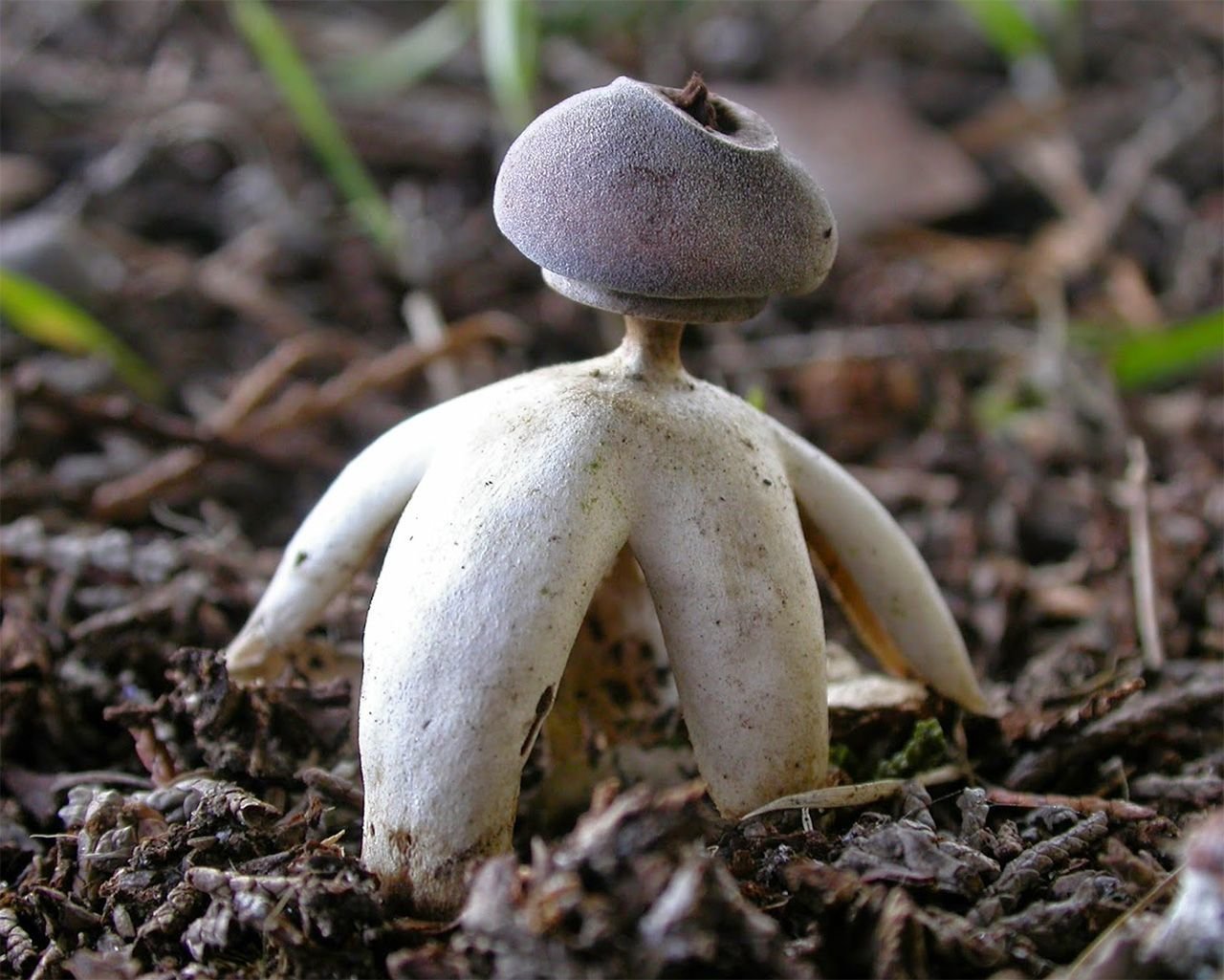 Description
Description
Fruiting bodies are initially closed, spherical, about 2 cm in diameter, covered with a peridium, along the entire surface of which mycelial strands are located; mature - open, 3-5 cm in diameter. Peridium is four-layer, consists of exoperidium and endoperidium. Exoperidium in the form of a bowl, three-layer or two-layer, hard, breaks from top to bottom to the middle into 4 unequal, pointed parts (lobes), bending down, and fruiting bodies rise up on the lobes, as on "legs". The outer mycelial layer is whitish, felt, covered with soil particles, soon disappears. The middle fibrous layer is white or isabella, smooth. The inner fleshy layer is white, also torn into 4 parts, with sharp ends resting on the sharp ends of the blades of the outer layer, soon disappears. The base is convex. The middle rises up together with the inner part of the fruiting body - the gleba. The spherical or oval (ovoid) glebe is covered with endoperidium, 0.9-1.3 cm high and 0.7-1.2 cm wide.At the base with a flattened leg, above which the endoperidium is narrowed and a well-visible rounded protrusion (apophysis) is formed, at the apex it opens with an opening, which is equipped with a low peristome. The peristome is conical, fibrous, with a sharply limited courtyard, smoothly fibrous-ciliate, around which there is a clear ring. The stem is cylindrical or slightly flattened, 1.5-2 mm high and 3 mm thick, whitish. The column is cotton-wool, light brown-gray in section, 4-6 mm long. Its exoperidium ruptures more often by 4, less often by 4-8 unequal pointed lobes, bending downward, which is why the entire fruiting body rises up on the lobes, as on legs.
The leg (in the traditional sense) is missing.
Gleba is powdery when ripe, black-purple to brown. Spores are brownish, light or dark brown.
When pressed, the spores fly in all directions. Spores are olive brown.
HABITAT AND GROWTH TIME
The four-bladed starfish grows mostly on sandy soil in deciduous, mixed and coniferous - pine, spruce, pine-spruce and spruce-deciduous forests (among fallen needles), sometimes in abandoned anthills - from August to October, rarely. Recorded in Russia (European part, Caucasus and Eastern Siberia), Europe and North America. We found it southeast of St. Petersburg in a mixed forest (birch and spruce) under an old spruce on needles in early October (the mushrooms grew as a family).
TWINS
The four-bladed starfish is very peculiar in appearance and is strikingly different from mushrooms of other genera and families. It is similar to other starfish, for example, to the Vaulted starfish (Geastrum fornicatum), whose exoperidium splits into two layers: the outer one with 4-5 short, obtuse lobes and the inner, convex in the center, also with 4-5 lobes; on Zvezdovik crowned (Geastrum coronatum) with leathery, smooth exoperidium, splitting into 7-10 gray-brown pointed lobes; on Fringed Starfish (Geastrum fimbriatum) with exoperidium, which is torn by half or 2/3 - by 5-10 (less often up to 15) unequal blades; on Zvezdovik striped (G. striatum) with exoperidium, bursting into 6-9 lobes, and light gray gleb; on the small Starfish Shmiela (G. schmidelii) with exoperidium, forming 5-8 lobes, and a gleba with a beak-shaped grooved striped nose; on Zvezdovik triple (Geastrum triplex) with a fibrous hole at the top of a gray-brown block.
It is confined to the soils of deciduous and coniferous forests.
Zvezdovik (geastrum)
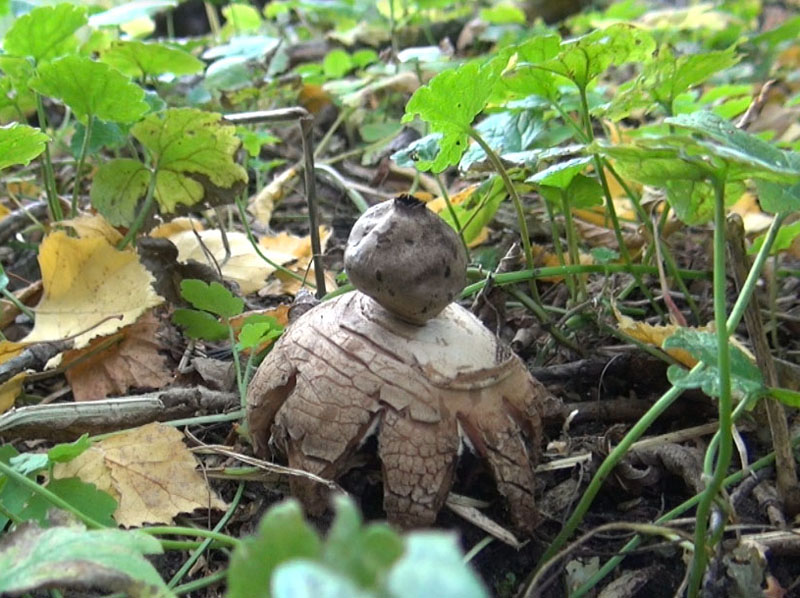
Seeing an asterisk on which something round sits, even experienced mushroom pickers are amazed, starting to wonder if such a miracle has flown into the Russian forest from another planet. Zvezdniks are rare mushrooms, and people don't always notice them - simply because of their focus on the classic image of a mushroom as a cap on a stem. A round ball on an asterisk does not fit into the usual concept, and the gaze of the miners slips by. Meanwhile, starfish are some of the most unusual mushrooms in the world. There is no need to collect them, but it is interesting to stop and admire this freak of nature.
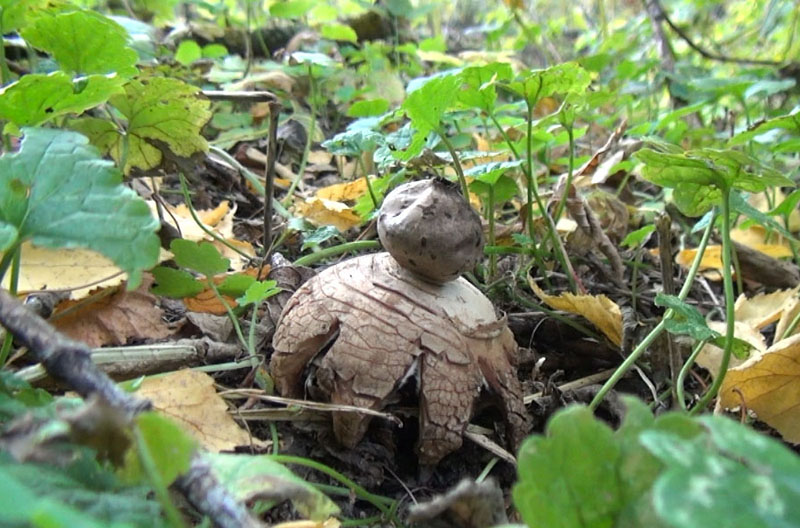
The Latin name for starfish - Geastrum (geastrum) - connects two roots: "earth" and "star". Starfishes settle on dense leafy lining or vegetation debris. Referring to saprotrophs, starfish close the circuits of the cycle of substances, processing plant organic matter and returning inorganic compounds to the soil, which can be used by living trees as nutrients.
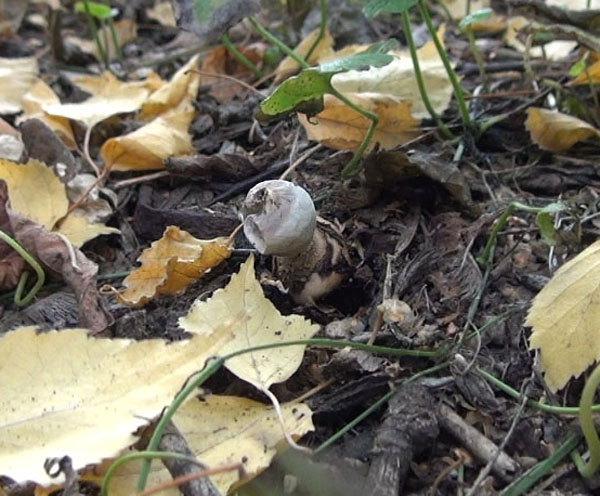
The young mushroom has a peculiar shell. As it grows, it breaks, forming a stellate structure that lifts the spore sac. It turns out an exotic mushroom, which is difficult to recognize as such.
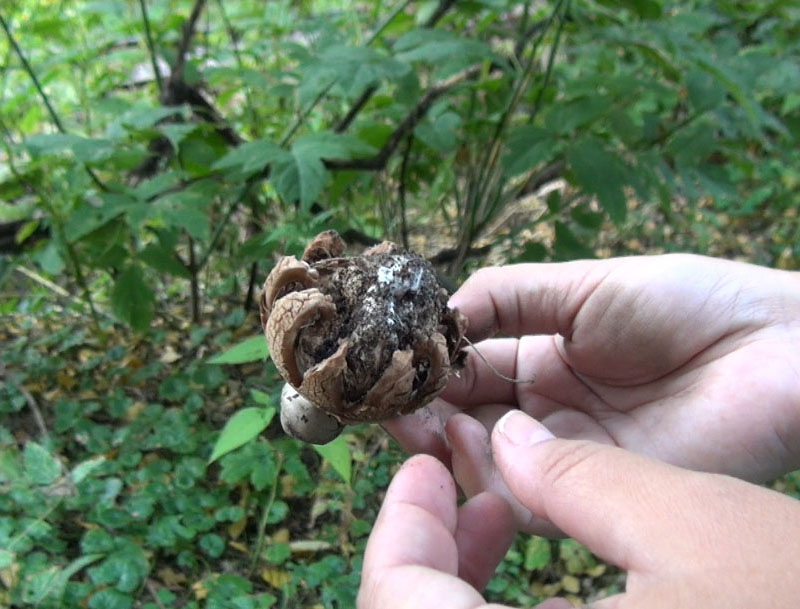
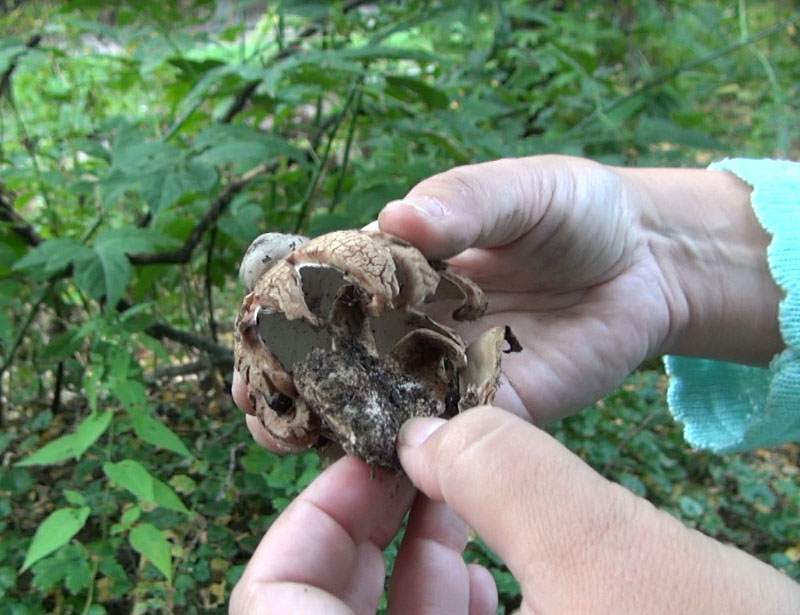

Celebrities live all over the world and almost everywhere. Some species prefer open and high places under deciduous trees, others choose dark coniferous thickets, there is. Colonies of fungi can exist in one place for many years, since spores are well preserved in a dense round sac on top.Often, in place of one mushroom, the next one sprouts. And if you find one starlet, several more can be found within a radius of several meters.
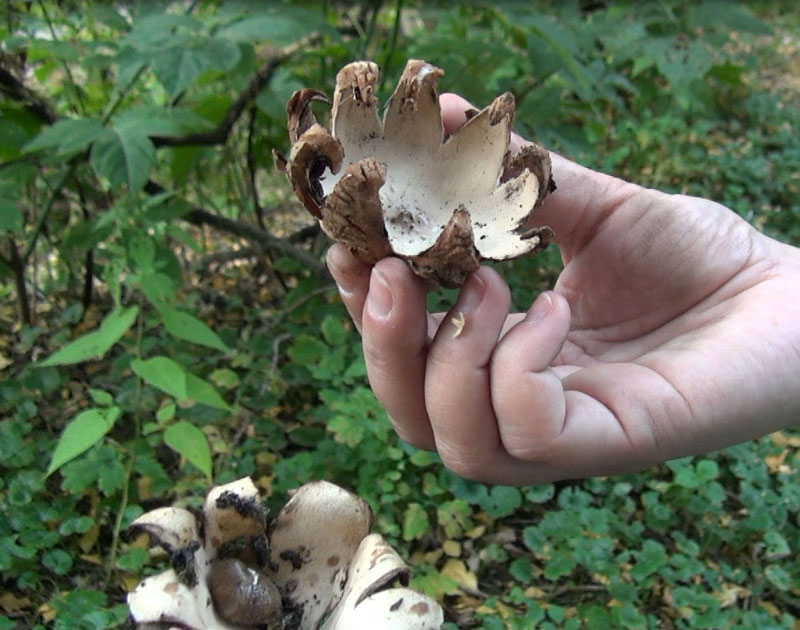
Some species of starfish are edible at a young age; the fruit body with a shell can be eaten even raw. But the expediency of such eating, generally speaking, is questionable. And the definition of the species is a difficult task even for specialists. It's easier not to risk leaving the stars in their place.
The stars shown in the pictures in this post were not found in the forest or even in the park. They were almost accidentally discovered in the city, during a leisurely walk along an uncrowded path along the industrial zone. From the pictures on the Internet, I identified the mushroom found as striped starfish. Its distinguishing feature is the characteristic cracked stripes on the asterisk. But it is possible that this is a fringed starfish or some other representative of the family.

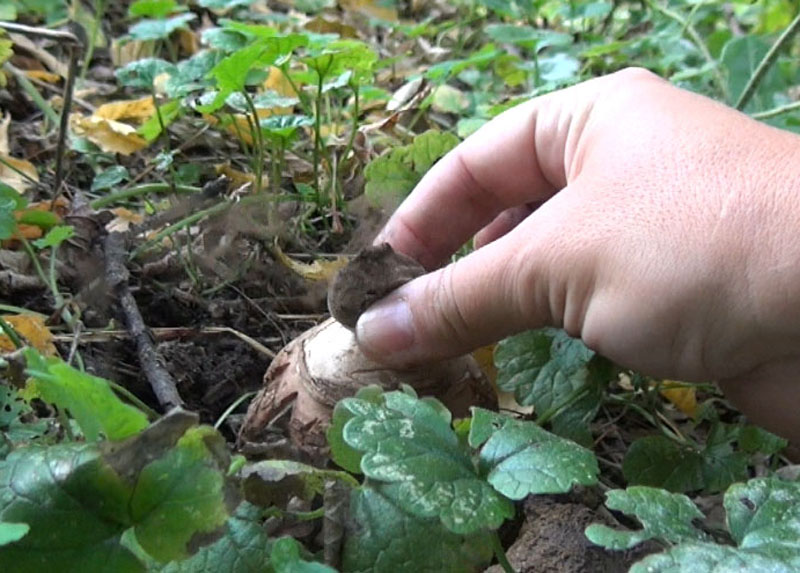
Zvezdoviks are essentially raincoats, the round pouch at the top contains spores, and just like other ripe raincoats, you can “puff” on them. The brown "smoke" coming out from above is the spore.
Text - Lazy Summer Resident, photo - Anton Ageev
Fringed starfish, Geastrum fimbriatum
Fruit body: Gasteroid; initially spherical, submerged or semi-submerged in the litter, 2-5 cm in diameter (at this stage of development). As development progresses, the outer shell-exoperidium exfoliates, remains flattened over the substrate (the diameter of such a “projection” can reach up to 10 cm), cracking along the edges, although, as a rule, it does not form a clear “star-shaped” shape typical of many other relatives. The "rays" are irregular, usually tuck inward. On these "rays" sits a round spore-bearing sac, in which spores ripen - after ripening they fly out through a tousled gap in the upper part (therefore, probably, this starlet is called "fringed"). The color is variable - at an early stage it is grayish-white, then it tends to variety. The ruptured exoperidium retains its original color for a long time, and the spore-bearing sac darkens over time; at the last stage of development, the maturing spores cover the entire fungus with the same tobacco-rusty color. The flesh of exoperidium is white, fragile; in the spore-bearing part - like all raincoats. First white and wadded, then turns yellow, darkens, turns into dust. There are no reports of any distinct taste or smell of pulp.
Spore powder: Brown.
Spreading: It is indicated that Geastrum fimbriatum - cosmopolitan, spread literally everywhere. It can grow anywhere, but somewhat often found in pine forests, on sandy soils. It comes across infrequently, but often bears fruit in large groups. The traditional time of fruiting in our area is the beginning and middle of autumn.
Similar species: It differs from other common representatives of the genus Geastrum fimbriatum in its unevenly splitting exoperidium (not so similar to a neat little star in moss), in that the light-colored exoperidium grows through fragments of forest litter, and also in the noticeable “fringed framing” of the hole for the ejection of spores in mature specimens ... There are a lot of similar species (to name at least Geastrum triplex - with a three-star exoperidium, G.rufescens - a reddish color, G. pectinatum - this spore-bearing sac on a leg, and so on), but for the most part they confidently differ from the fringed starfish in external featured.
Edibility: In culinary terms, the fringed starfish is similar to all raincoats - it is edible until the maturation of the spores begins (that is, as long as the pulp remains white). It is indicated that this starfish is tougher than other gastromycetes, which theoretically should be a plus.
Author's notes: At first glance, one might consider the starlet to be a simple raincoat with inflated self-esteem. "Raincoat star fever". Such exquisite forms seem to be out of order for these simple mushrooms.But then I recall, I recall from fiction, how barefoot village children run through the thickets of mature raincoats, knocking out the tobacco spirit, and wise old people condescendingly refer to this mushroom as “wolf sigh”. (This was told to me at the dawn of time by my great-grandmother, who was proud of her village roots.) Now imagine that every raincoat (flap, bighead - not the essence) is a star. Star. Who do you need to be to scoff in word or deed at the earthy stars that have sprung up in the moss?
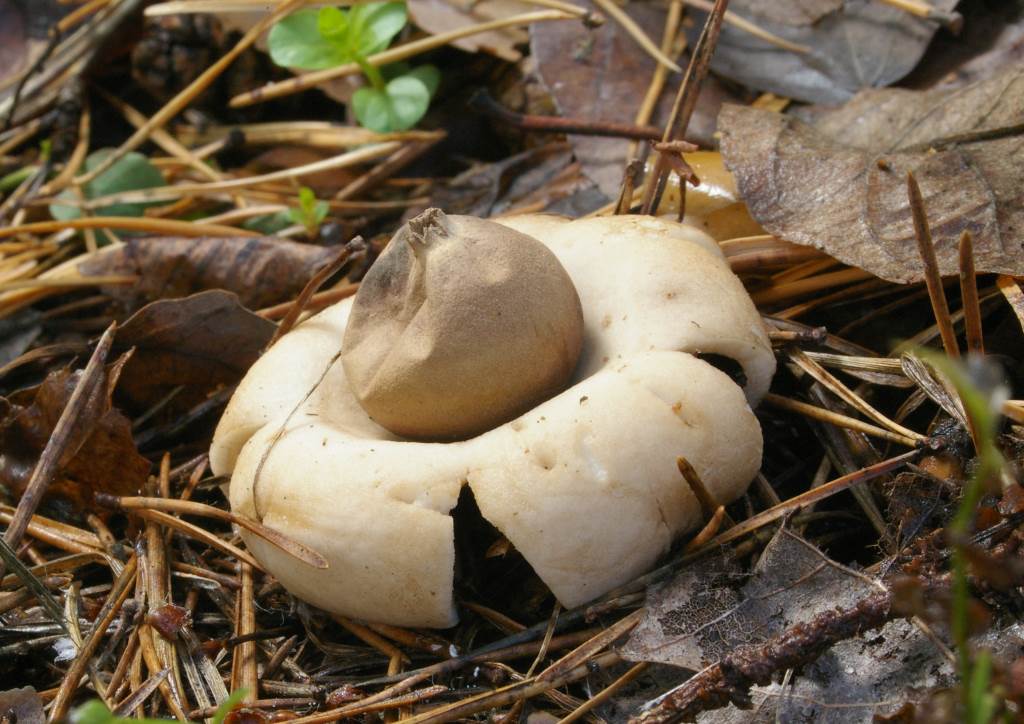
Mature, well-formed starlet
You should pay attention to the fringed (! -So) hole in the upper part of the bag
It is said in some places that this rather ordinary-looking sign is the most true.
Vaulted earth star with description
- Family: Earth stars (Geastraceae).
- Synonyms: vaulted starfish.
Description. The earthen star fungus is vaulted with medium-sized fruiting bodies, developing first underground or partially submerged, then on the surface of the soil.
The fruiting body is spherical at first, 3-8 cm in diameter, then the outer integumentary layer (exoperidium) breaks into 3-5 (most often 4) rays, and it becomes vaulted; rays are often almost vertical, attached by their ends to the mycelial calyx, which is covered on the outside with particles of soil and litter, and whitish to light brown inside. The rays are almost always straight and vertical, raising the fruiting body high above the soil, with tucked edges and looking narrow. Ray length 2-5 cm, width 3-4 cm. The remaining inner part is spherical, on a pedicle 2-3 mm high, gray-brown, at the apex with an indistinctly bordered hole (sometimes). The pulp is initially white; when ripe, it is almost completely transformed into a dark brown spore mass.

